Introduction
Alphacool ST30 X-Flow 360mm Radiator Review
Welcome to another Extreme Rigs radiator review. Today our attention is on the NexXxos ST30 X-Flow 360mm which is another model from Alphacool’s ever expanding and extremely popular range of water cooling radiators.
In this ST30 X-Flow review we’ll share the results of our thermal performance and restriction testing. We’ll also take a look at it’s construction, analyze the performance data and compare some of it’s results against the regular ST30 360.
Firstly a big thanks to Aqua Tuning for providing the Alphacool ST30 X-Flow review sample. The ongoing support offered by Aqua Tuning is greatly appreciated by Extreme Rigs and ultimately means you the reader can make more informed purchase decisions.
What’s in the Box?
The ST30 X-Flow sample arrived in full retail packaging consistent with the Alphacool NexXxos range.
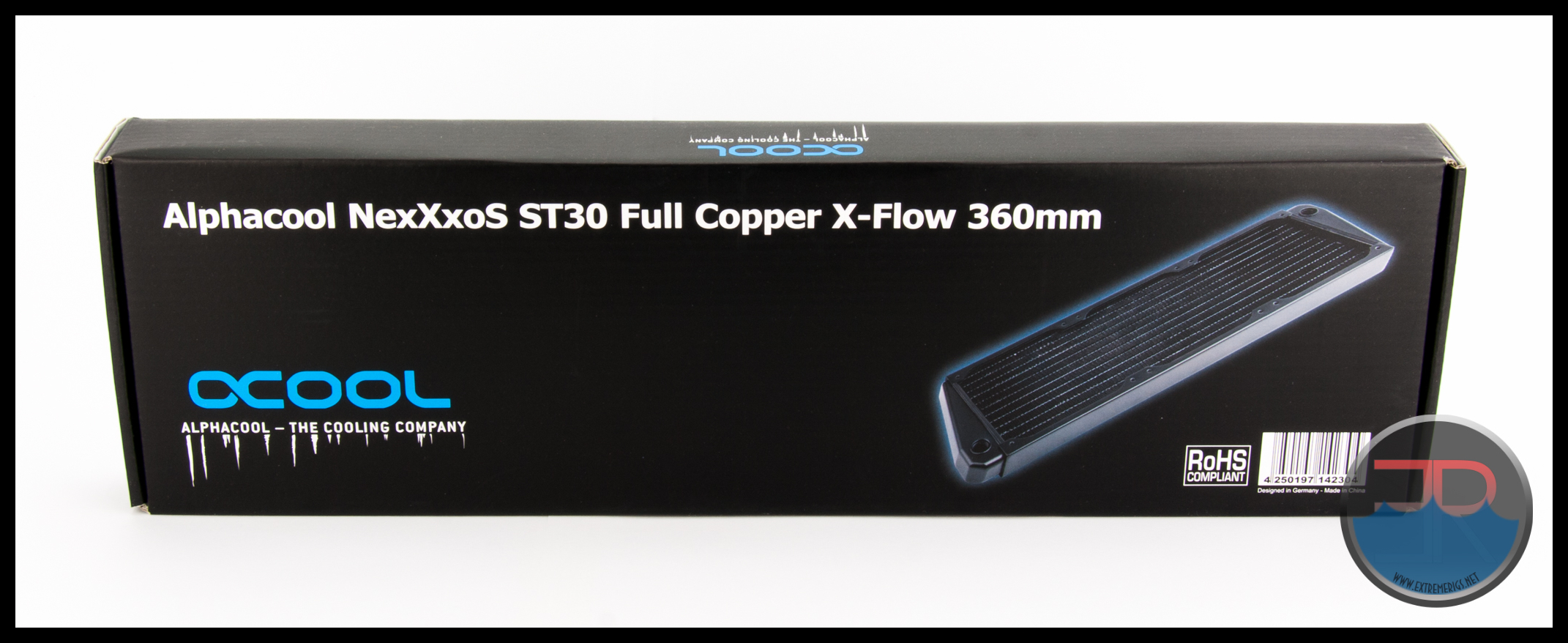 Flipping the lid on the box we see the familiar internal packaging layout.
Flipping the lid on the box we see the familiar internal packaging layout.
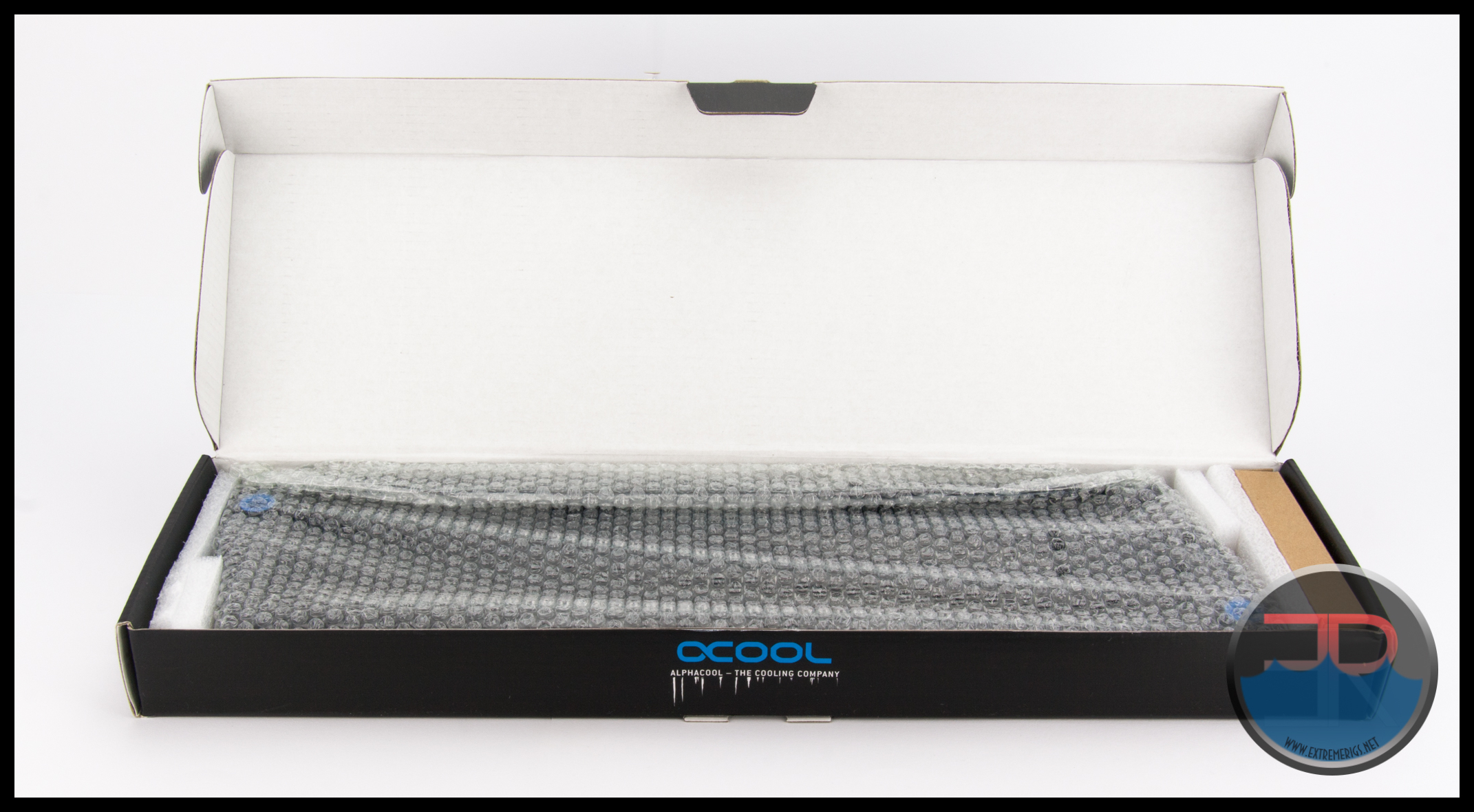 The radiator is enclosed in a bubble wrap bag and at one end is a small cardboard box which contains the included accessories. Small foam pieces have also been placed at each end to prevent movement during shipping.
The radiator is enclosed in a bubble wrap bag and at one end is a small cardboard box which contains the included accessories. Small foam pieces have also been placed at each end to prevent movement during shipping.
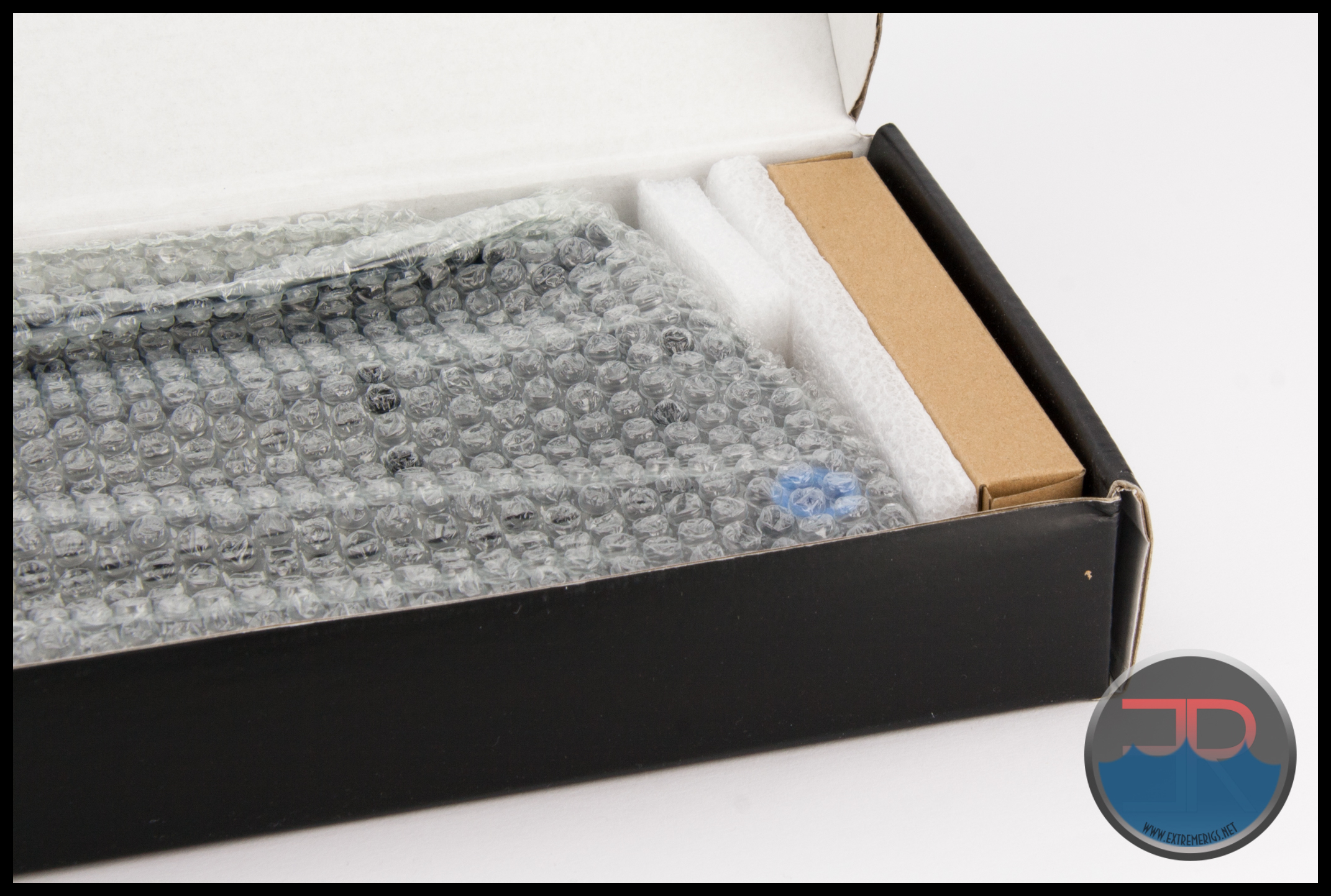 Alphacool usually package their products extremely well and the ST30 X-Flow is no exception. Every effort has been made to ensure the product arrives to the purchaser in tip top shape.
Alphacool usually package their products extremely well and the ST30 X-Flow is no exception. Every effort has been made to ensure the product arrives to the purchaser in tip top shape.
Extent of Delivery: (as listed by Alphacool)
1x Radiator
2x screw plug
Mounting Material
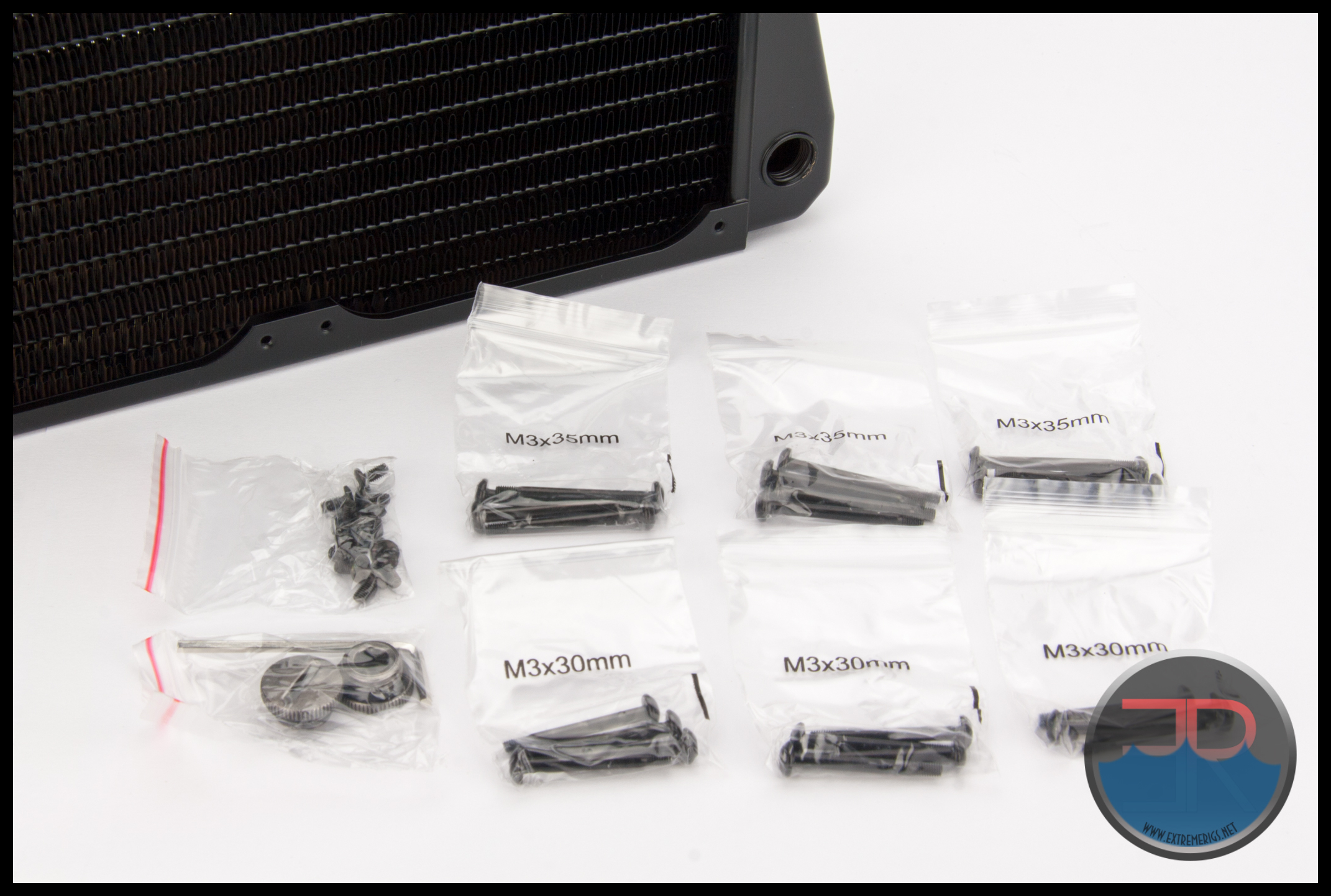 Inside the accessory box pictured above are 8 x zip lock bags:
Inside the accessory box pictured above are 8 x zip lock bags:
3 x bags: M3 x 30mm (12 screws)
3 x bags: M3 x 35mm (12 screws)
1 x bag: M3 x 6mm (12 screws)
1 x bag: 2 x Stop Plugs and 1 x Allen Key
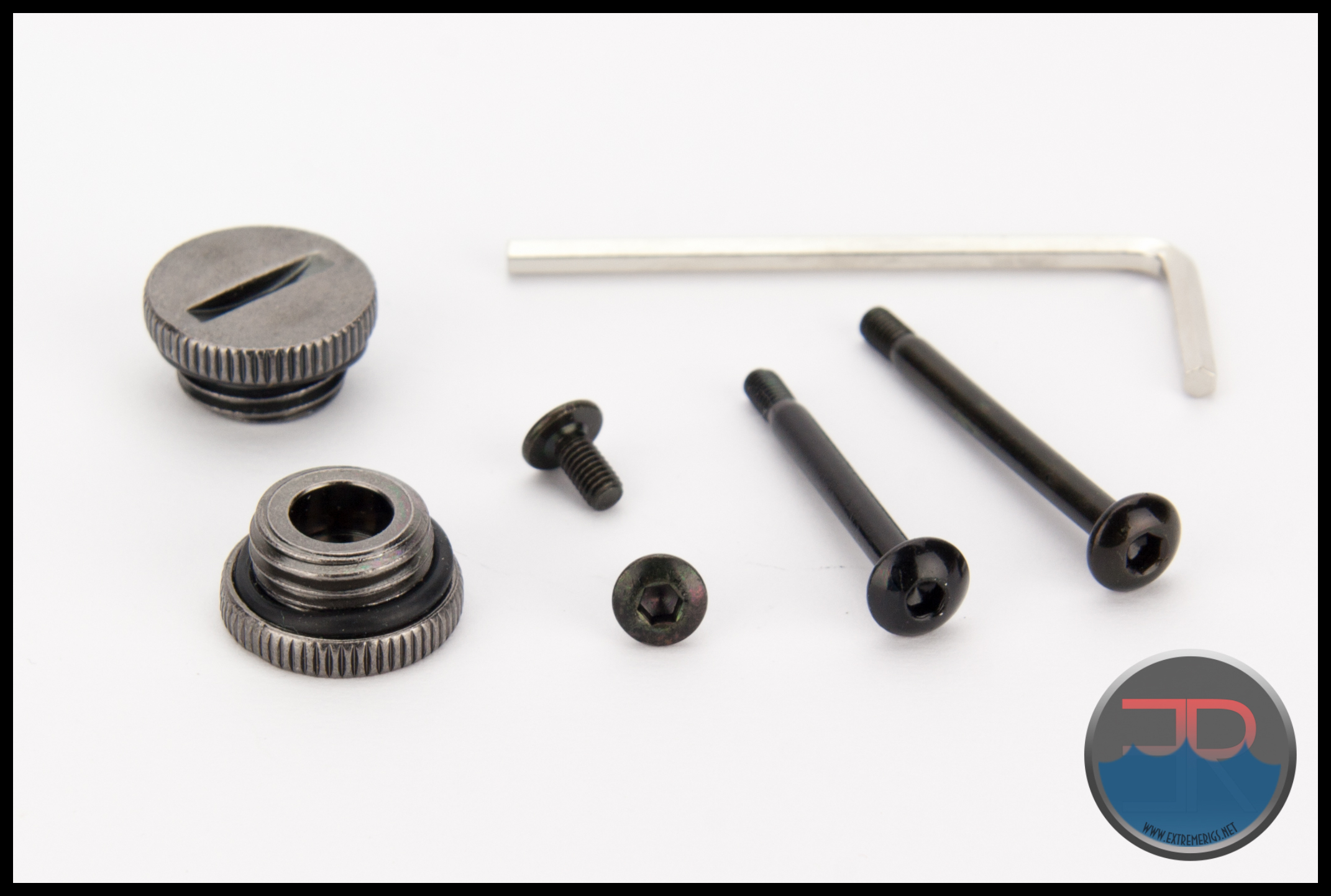 Only the last ~4mm on both 30mm and 35mm screw sets have been threaded before a short taper into a thicker shank. We certainly like this process because it is a fail safe for radiator punctures often caused from wrong length screws being used.
Only the last ~4mm on both 30mm and 35mm screw sets have been threaded before a short taper into a thicker shank. We certainly like this process because it is a fail safe for radiator punctures often caused from wrong length screws being used.
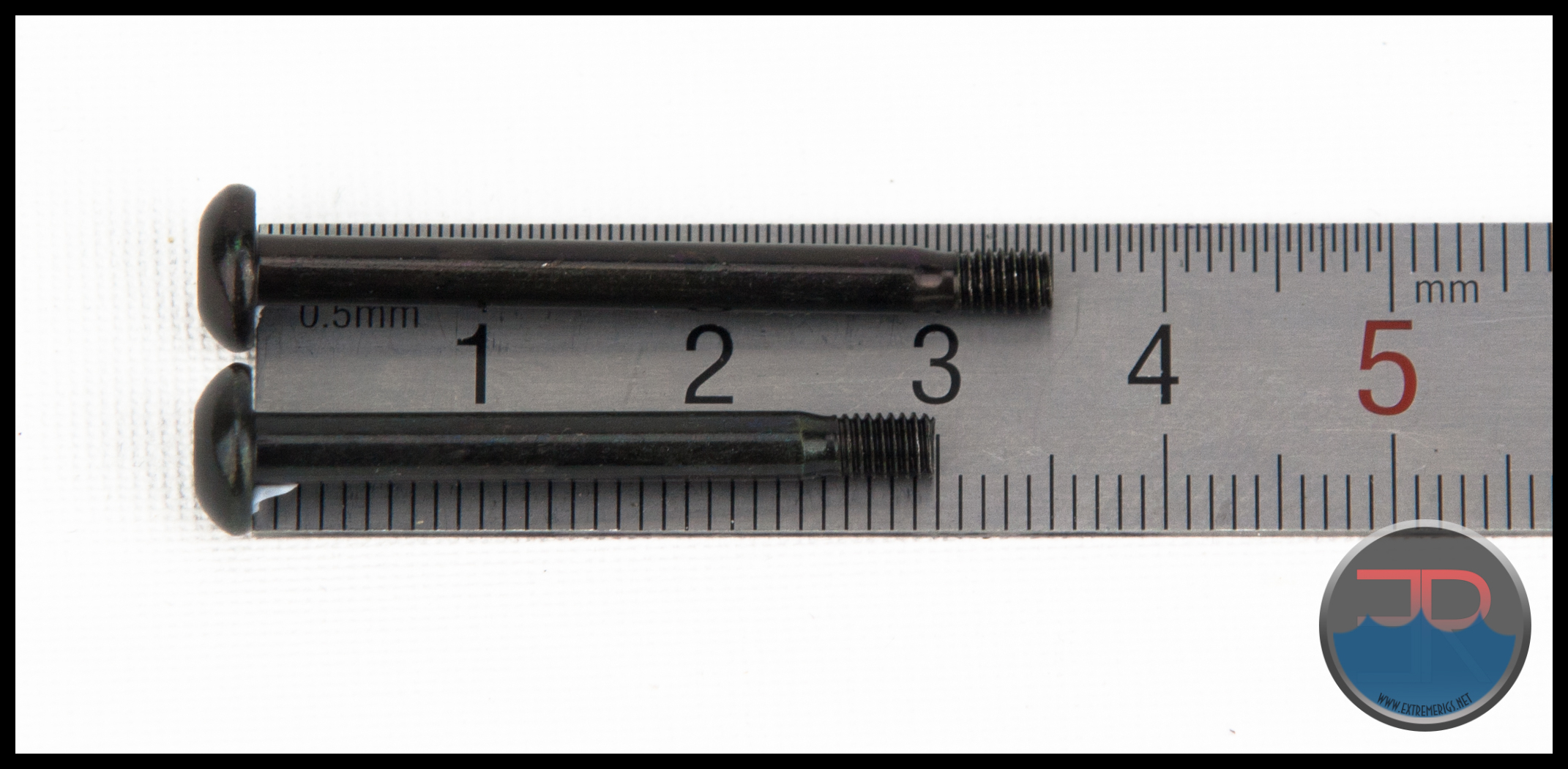 The screws in the short set measure ~6mm in length are ideal for attaching reservoir/pump brackets onto the radiator OR to mount the radiator directly to a chassis panel or radiator mounting bracket. There is a caveat with the second option though, the panel/bracket must have a cutout for the stop plug or fitting at each end.
The screws in the short set measure ~6mm in length are ideal for attaching reservoir/pump brackets onto the radiator OR to mount the radiator directly to a chassis panel or radiator mounting bracket. There is a caveat with the second option though, the panel/bracket must have a cutout for the stop plug or fitting at each end.
All the screws are deep black and feature hex head drive slots and wide heads. M3 is not our preferred thread, but apart from that, the provided screw sets are as good as one could hope for and the included “bonus” Allen Key for installation/removal is a welcome inclusion.
The 2 x stop plugs provided are brass with a black nickel finish.
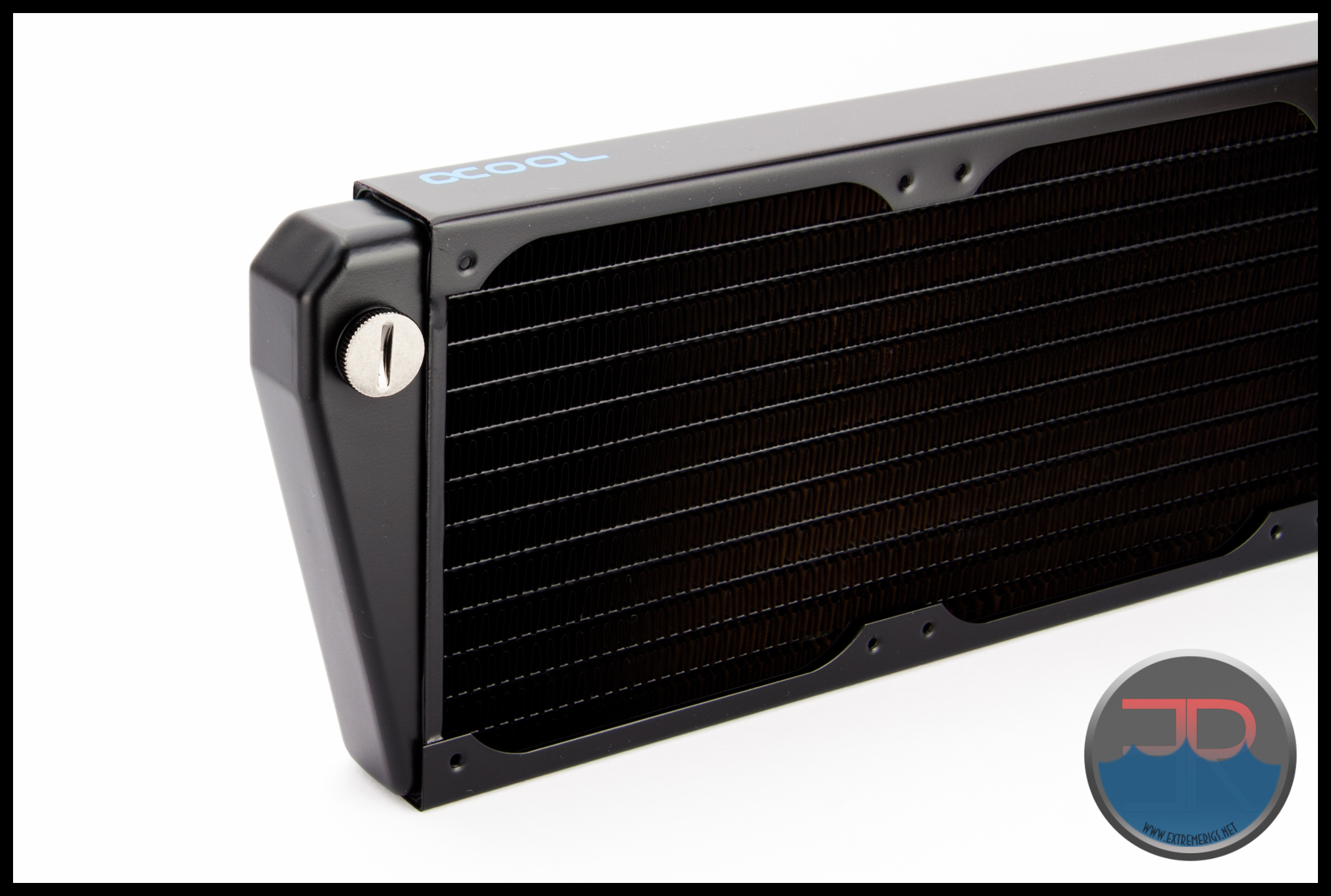 While certainly functional and the aesthetics may appeal to some users, we can’t help thinking that all black stop plugs such as those provided with the Eisdecke D5 Pump Top would be a better inclusion.
While certainly functional and the aesthetics may appeal to some users, we can’t help thinking that all black stop plugs such as those provided with the Eisdecke D5 Pump Top would be a better inclusion.
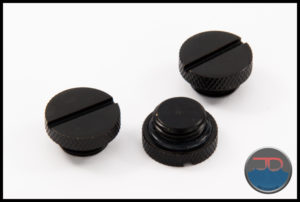
Onwards to technical specifications!

Technical Specifications
Technical Details and Features as listed by Alphacool
Technical specifications:
Material internal: Mostly copper
Material casing: Side panels steel, threads brass, copper chambers
Colour: Black
Dimensions (LxWxH): 413 x 124 x 30mm
Radiator size: 3x120mm
Connection threads: 4×1/4“
Mounting thread size: M3
Pressure tested: 1.5bar
Weight: 686g
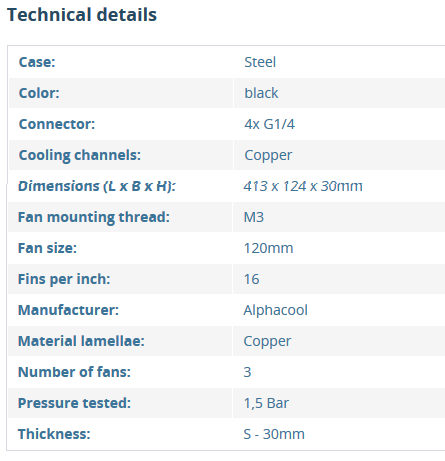 The following Technical Drawing is provided courtesy of Alphacool.
The following Technical Drawing is provided courtesy of Alphacool.
Dimensions Measured on the Radiator Tested:
 Our review sample measurements were virtually identical to those listed by Alphacool.
Our review sample measurements were virtually identical to those listed by Alphacool.
The 16mm thick core arrangement consists of single, finely louvered fins with a 15 FPI count between a single layer of twelve x 1.9mm thick tubes. The tubes are arranged in a single pass (X-Flow) configuration. This means that the coolant enters the radiator at one end, divides evenly to travel through all the tubes simultaneously in a single pass before exiting at the other end.
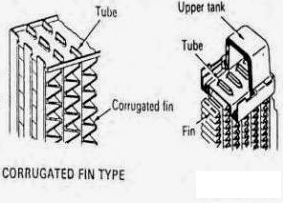 It is unlikely this thin, medium density core will produce outstanding performance results, it is a slim radiator after all, but we think ST30 X-Flow should do well with medium speed fans.
It is unlikely this thin, medium density core will produce outstanding performance results, it is a slim radiator after all, but we think ST30 X-Flow should do well with medium speed fans.
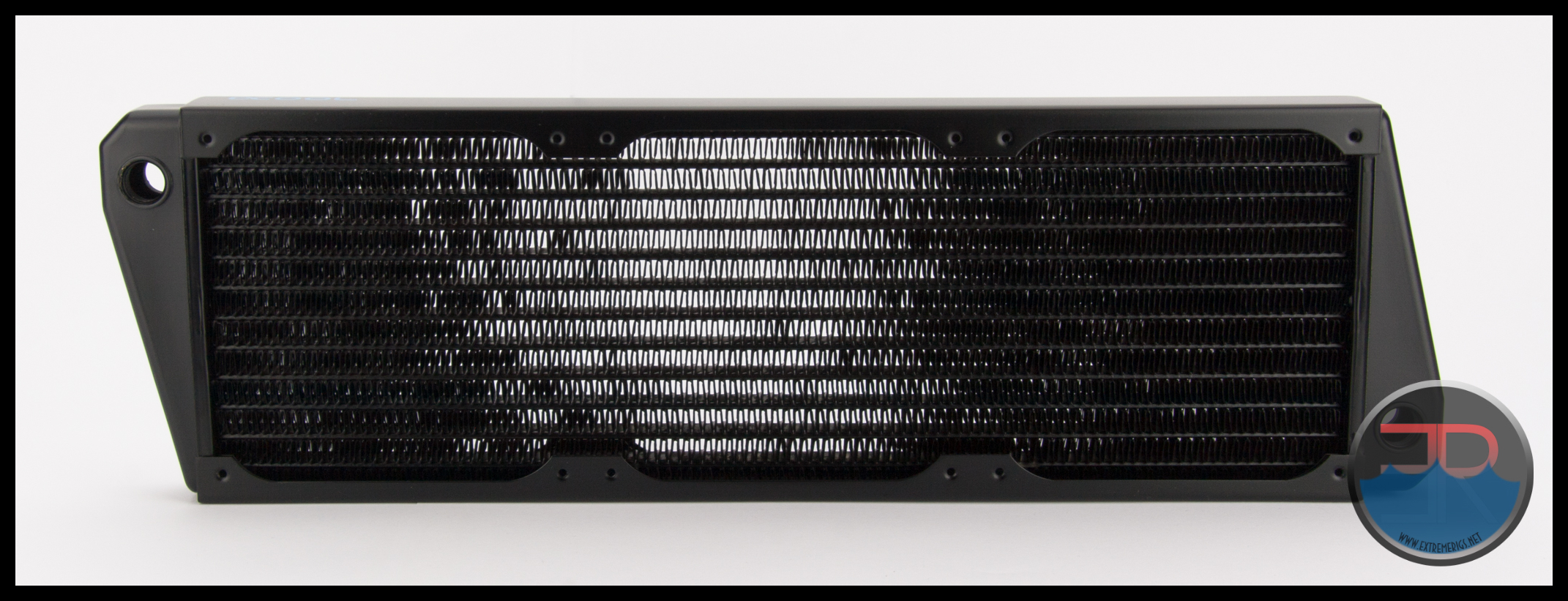 The 15 FPI count seems a good match for the core thickness and the fins were very evenly spread between the tubes on our review sample. We note here that the 15 FPI of the review sample is very slightly less than the 16 FPI stated in the specifications.
The 15 FPI count seems a good match for the core thickness and the fins were very evenly spread between the tubes on our review sample. We note here that the 15 FPI of the review sample is very slightly less than the 16 FPI stated in the specifications.
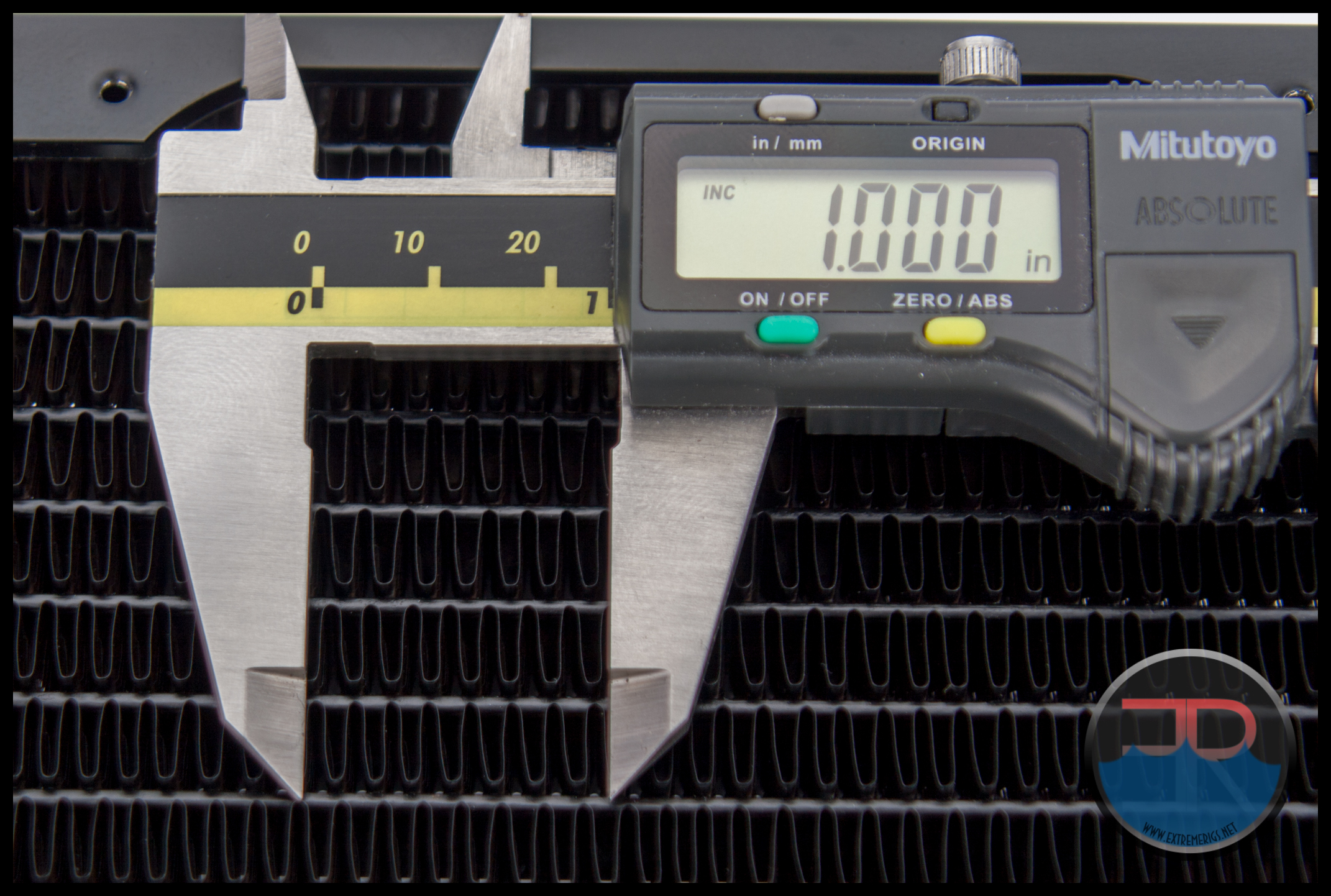 X-Flow radiators are usually less restrictive than their single layer dual-pass counterparts, but sometimes tube thickness is adjusted to keep the flow turbulent through the radiator. We’ll just have to wait until we get this sample on the bench to see how restrictive the ST30 X-Flow actually is.
X-Flow radiators are usually less restrictive than their single layer dual-pass counterparts, but sometimes tube thickness is adjusted to keep the flow turbulent through the radiator. We’ll just have to wait until we get this sample on the bench to see how restrictive the ST30 X-Flow actually is.
Finish and Features
With the current revision of NexXxos radiators (blue logos), Alphacool really have stepped up on the quality control. The satin black finish on our review sample was flawless and external joints all look to be well done.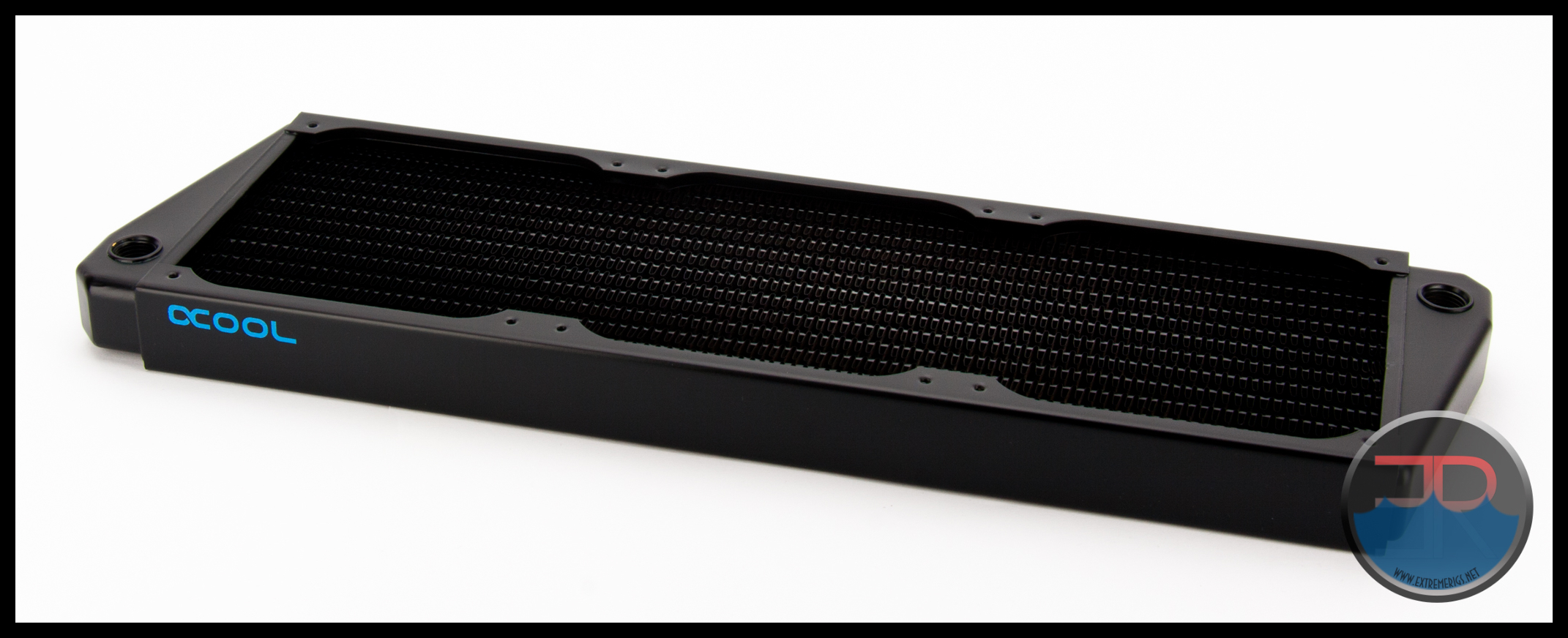 I am admittedly a fan of a matte black finish on radiators, but the deep black, satin finish of the ST30 X-Flow really impressed.
I am admittedly a fan of a matte black finish on radiators, but the deep black, satin finish of the ST30 X-Flow really impressed.
Company logos in conspicuous places is not something we favor, especially when they are placed so that there is a 50/50 chance that the logo will be upside down when the component is installed.
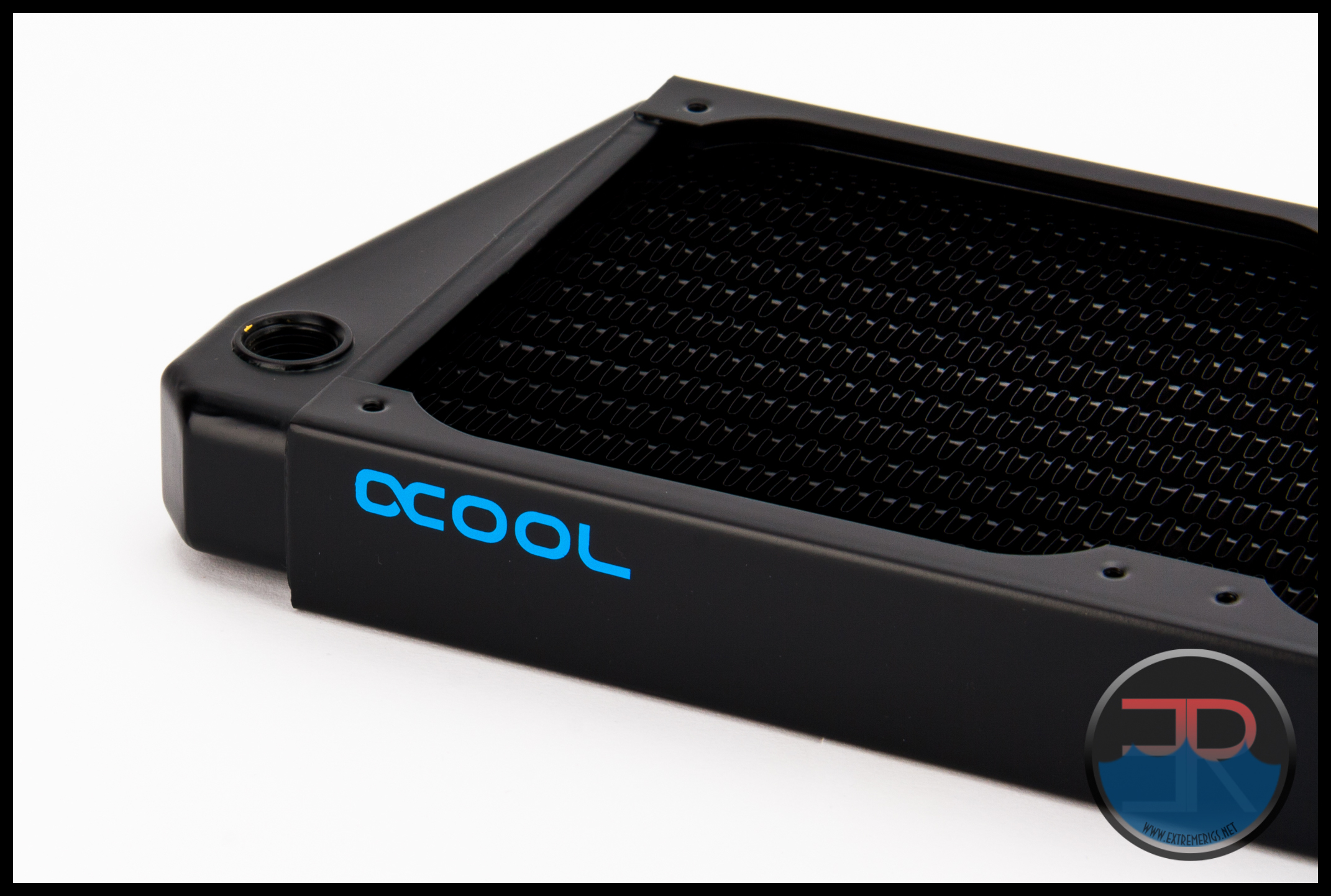 The ST30 X-Flow has the “acool” logo painted / printed on both side panels and being blue, it really stands out. Depending on your installation orientation the logo may end being upside down.
The ST30 X-Flow has the “acool” logo painted / printed on both side panels and being blue, it really stands out. Depending on your installation orientation the logo may end being upside down.
The ST30 end tanks are identical, but are installed with the ports on opposite sides at each end. The main (if not only) advantage of a X-Flow radiator is the ability in many installation scenarios to make tubing runs shorter which almost always equates to a neater looking system. This in our opinion is the ST30 X-Flow’s main draw while also taking up very little space (thickness only 30mm).
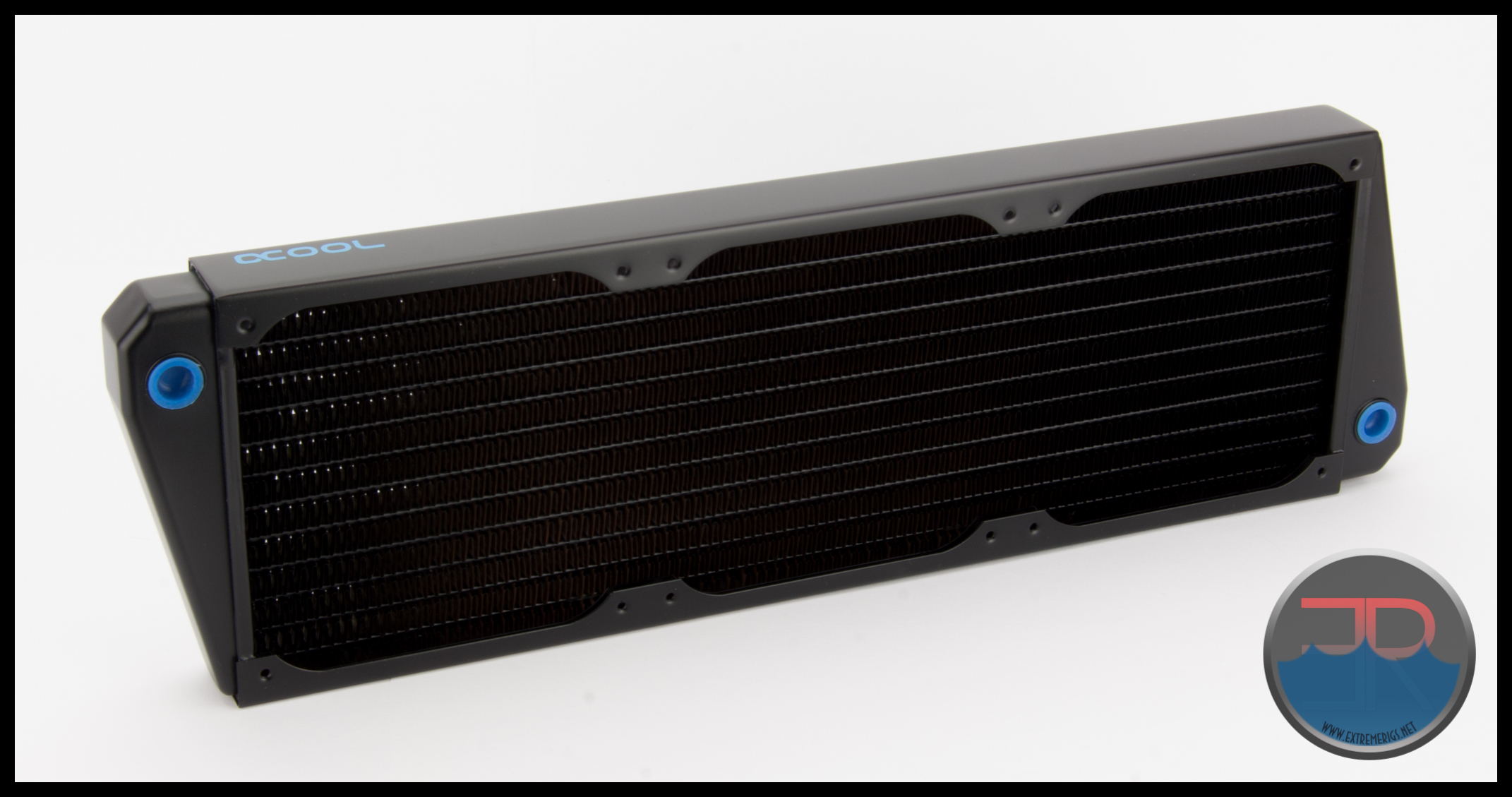 The tapered shape of the end tanks will greatly assist to eliminate dead flow spots and avoid trapped air pockets.
The tapered shape of the end tanks will greatly assist to eliminate dead flow spots and avoid trapped air pockets.
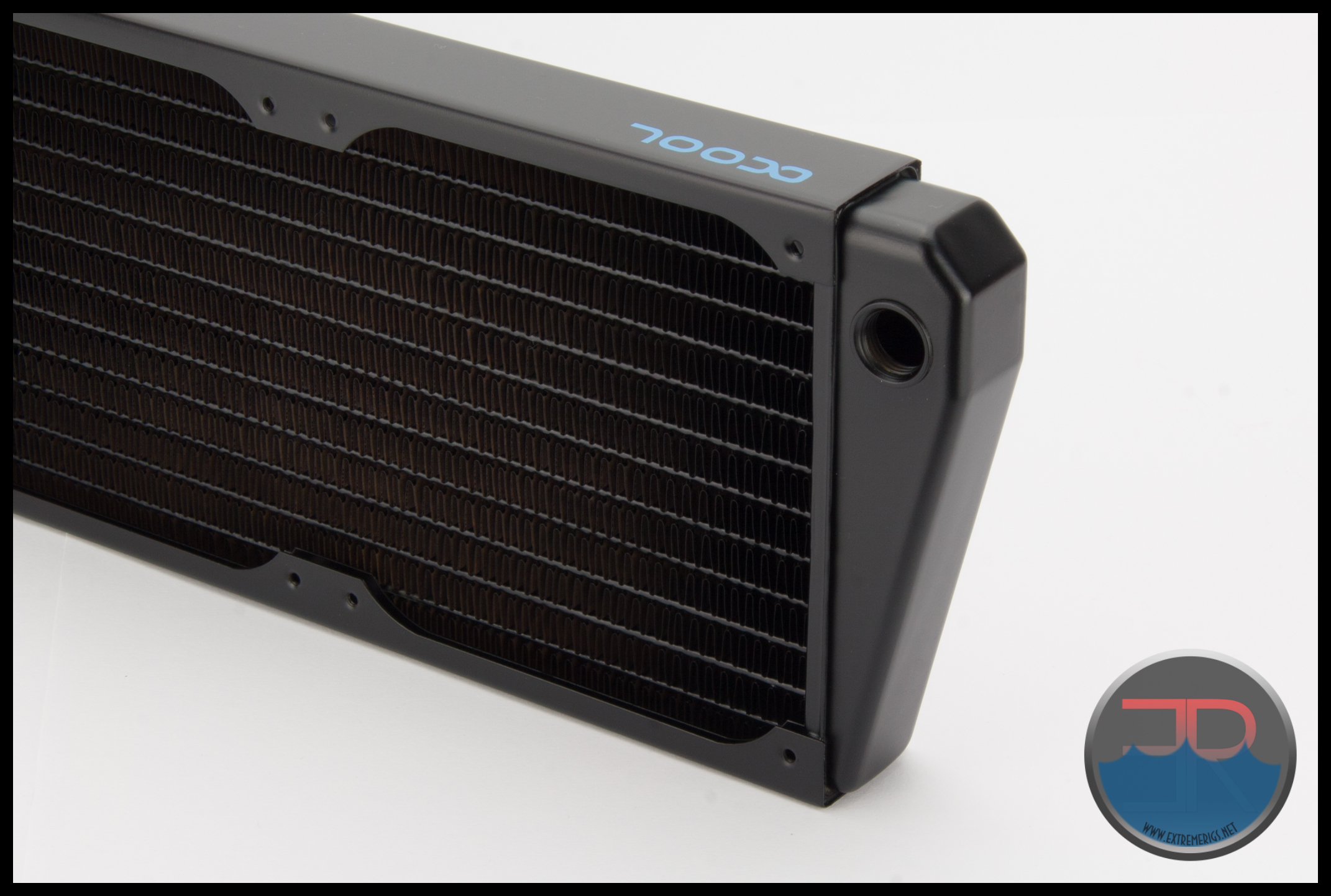 Each end tank is fitted with 2 x G1/4 ports which are opposite each other on the tank.
Each end tank is fitted with 2 x G1/4 ports which are opposite each other on the tank.
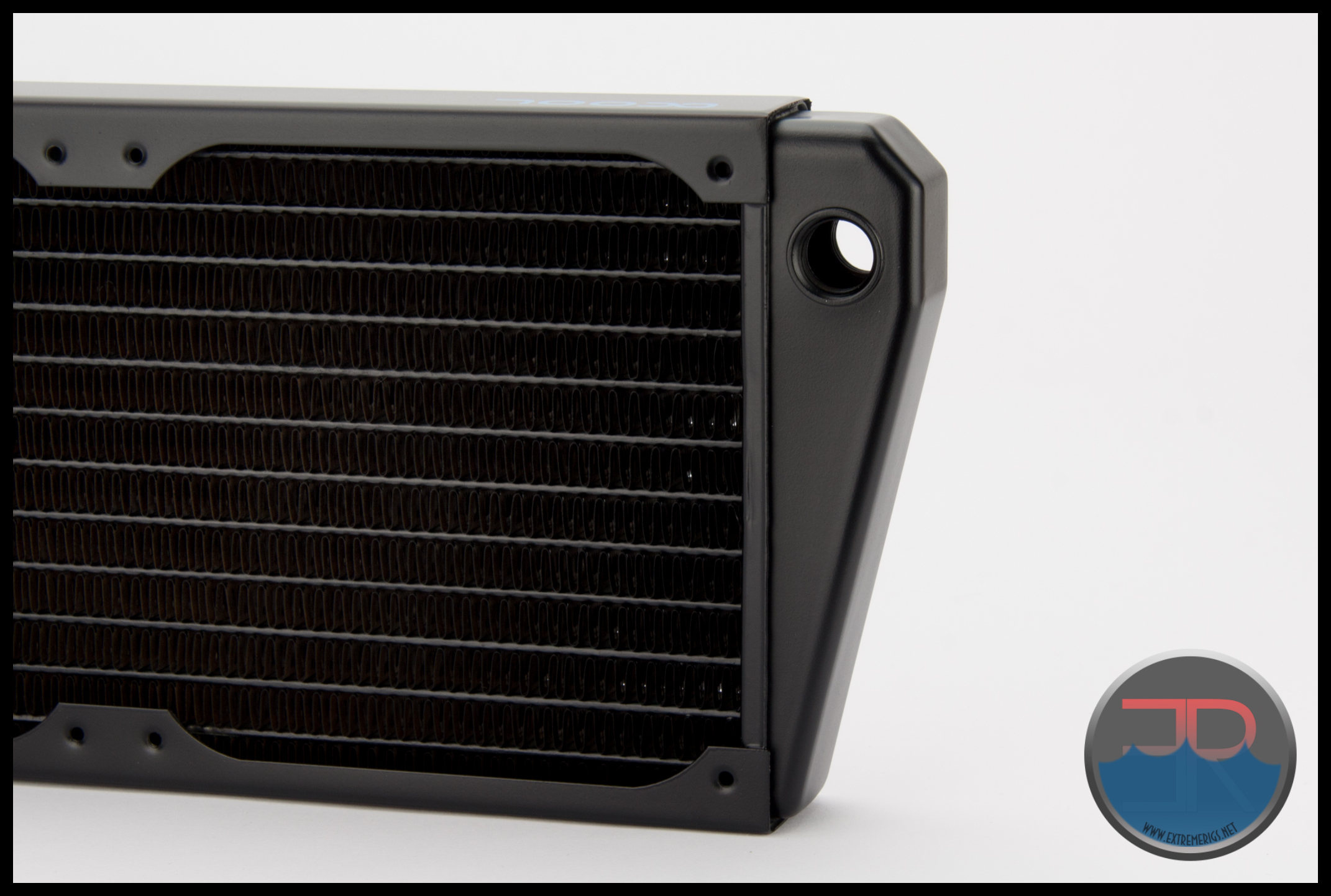 We think multi-port rads are the awesome, so we’re happy to see the The ST-30 X-Flow has not missed out on this feature. The extra ports can be used for a drain tap or temperature sensors and is often the easiest way to fill or bleed a loop when roof or floor mounted.
We think multi-port rads are the awesome, so we’re happy to see the The ST-30 X-Flow has not missed out on this feature. The extra ports can be used for a drain tap or temperature sensors and is often the easiest way to fill or bleed a loop when roof or floor mounted.
Note that when mounting the radiator directly to the chassis (no fan in between) some case modding may be required to accommodate the stop plug or other fitting which protrude past the radiator mounting points.
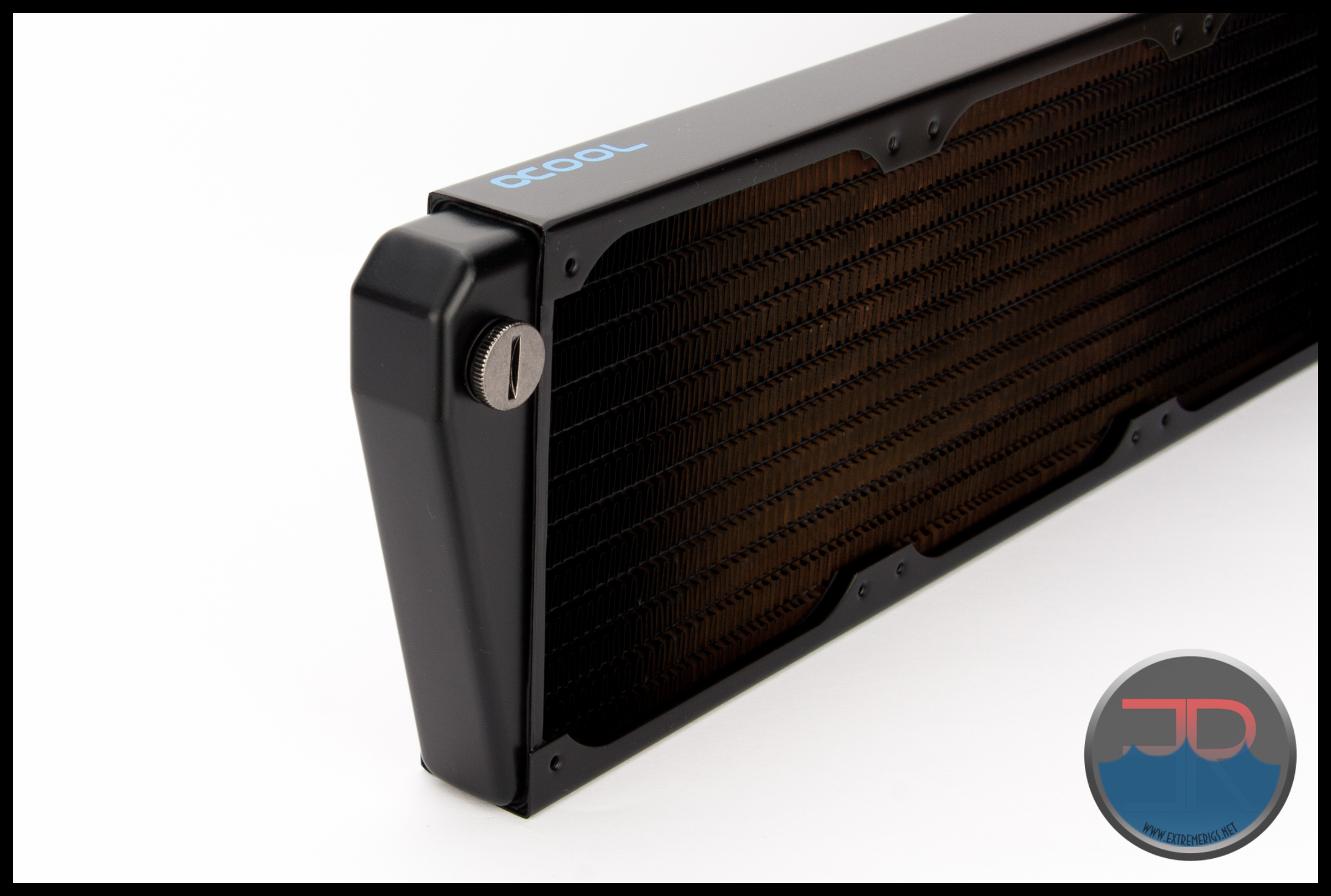 One thing we constantly complain about on Alphacool radiators is that the port threads are painted.
One thing we constantly complain about on Alphacool radiators is that the port threads are painted.
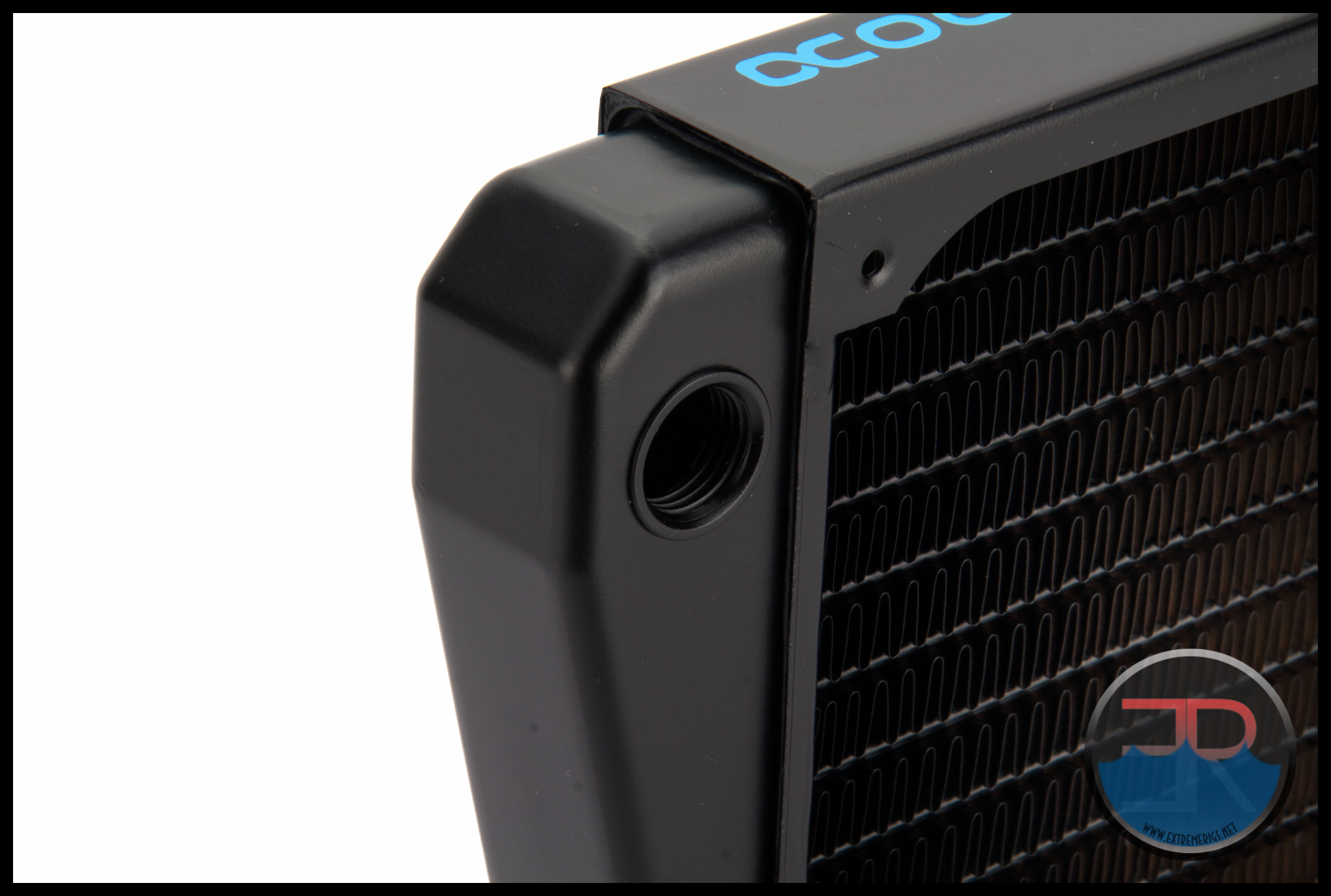 We see no valid reason for painting the threads and in fact makes it more likely that the end user will introduce paint chips into the system when installing their fittings.
We see no valid reason for painting the threads and in fact makes it more likely that the end user will introduce paint chips into the system when installing their fittings.
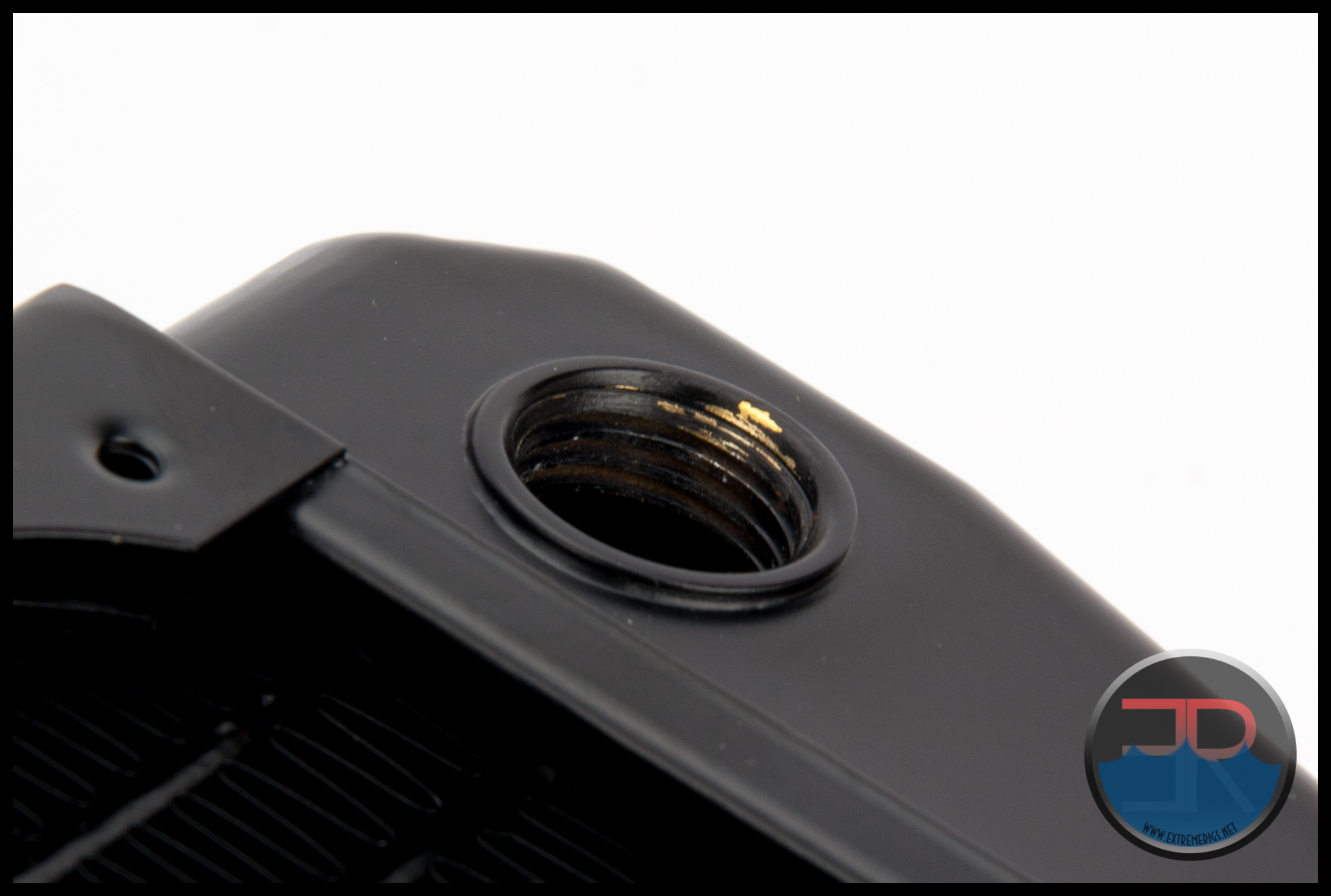 If you have a G1/4 tap, you might as well run it through the threads and clean out before flushing as I usually do.
If you have a G1/4 tap, you might as well run it through the threads and clean out before flushing as I usually do.
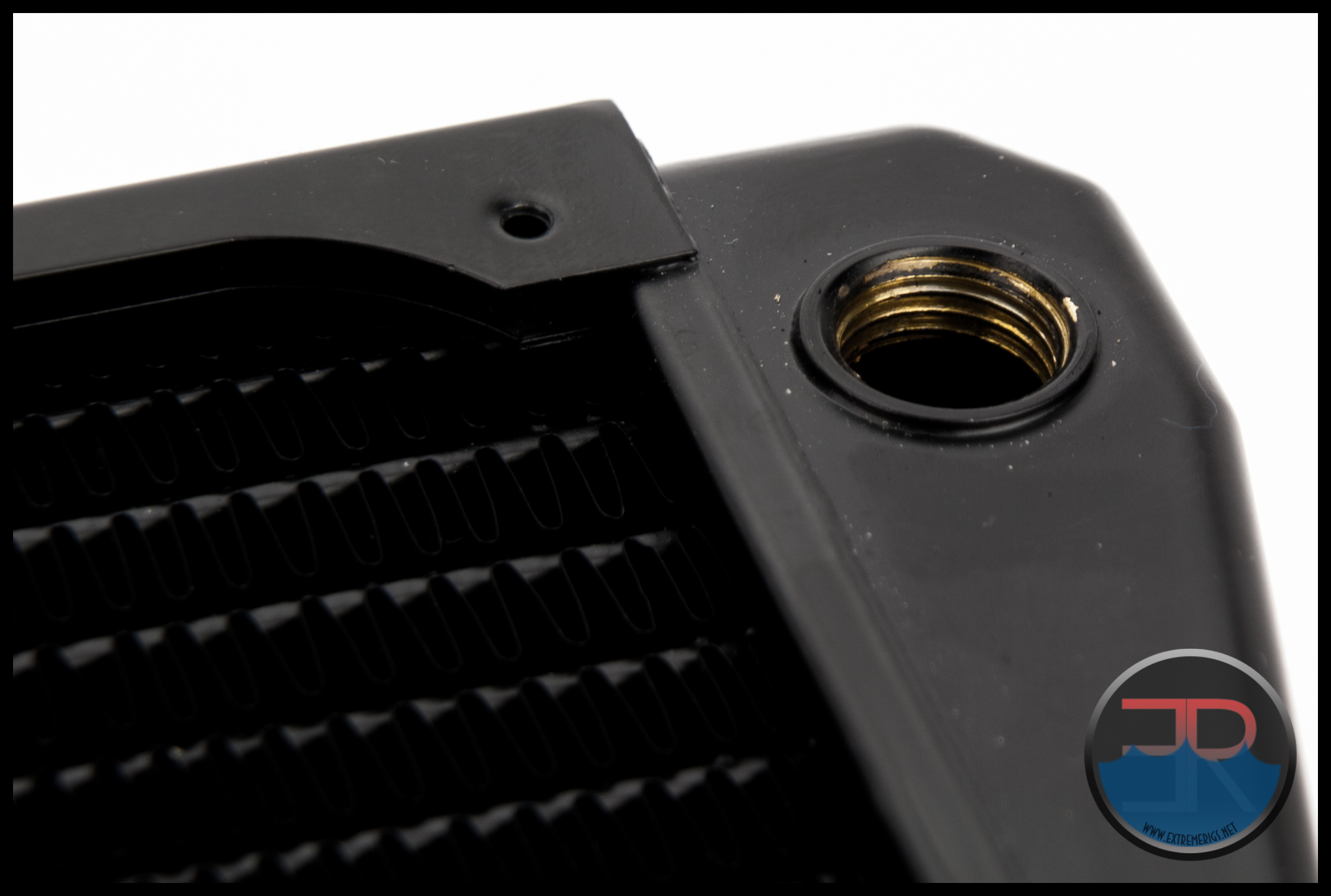 Alphacool’s deep black fittings are a perfect match to the ST30 X-Flow finish.
Alphacool’s deep black fittings are a perfect match to the ST30 X-Flow finish.
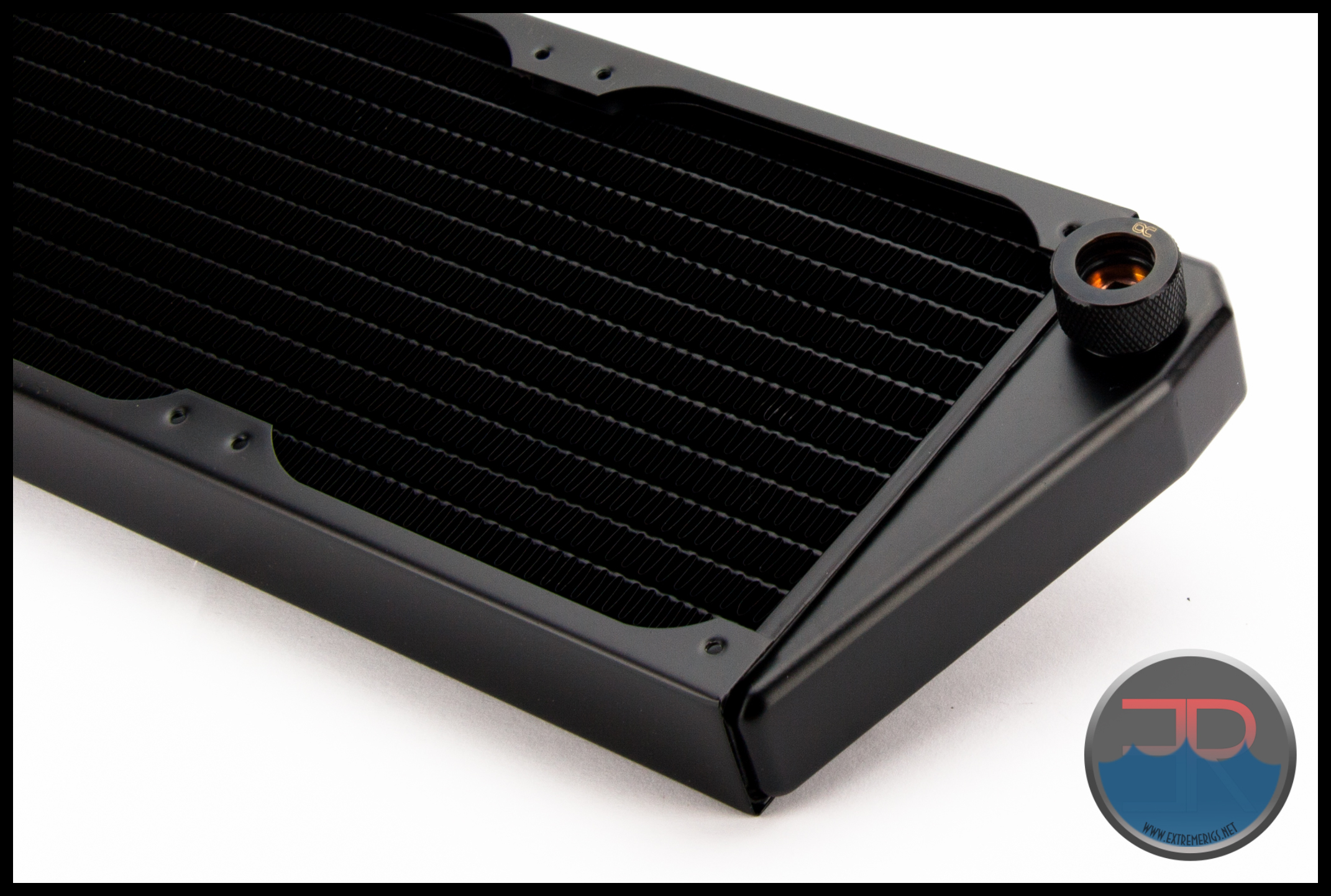 Shiny Nickel fittings look pretty good too!
Shiny Nickel fittings look pretty good too!
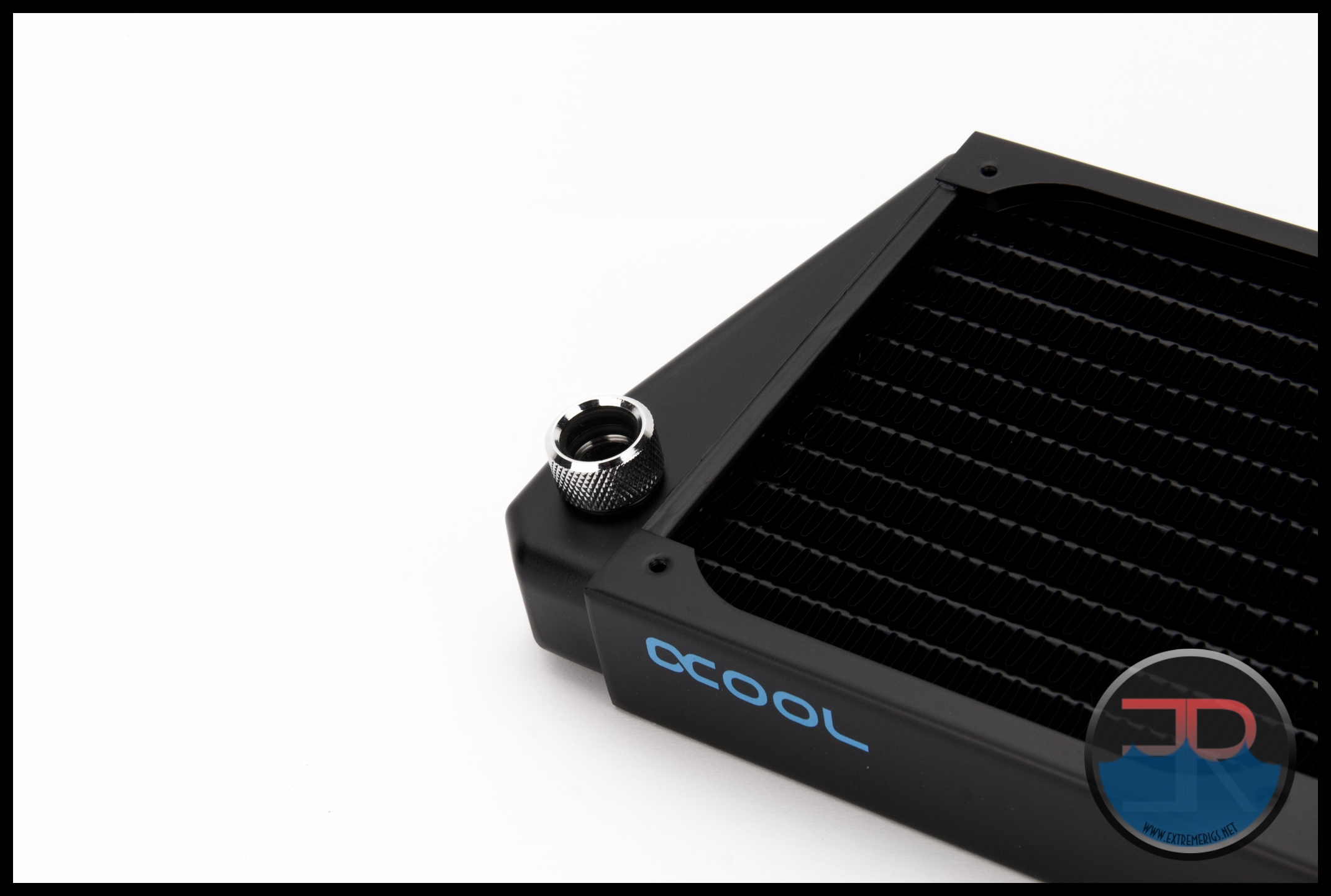 The large 26mm OD Bitspower 1/2 x 3/4 compression fittings probably wouldn’t fit if the G1/4 port was installed straight on our review sample. We guesstimate that a 24mm OD fitting would be the maximum size compatible with the ST30 X-Flow.
The large 26mm OD Bitspower 1/2 x 3/4 compression fittings probably wouldn’t fit if the G1/4 port was installed straight on our review sample. We guesstimate that a 24mm OD fitting would be the maximum size compatible with the ST30 X-Flow.
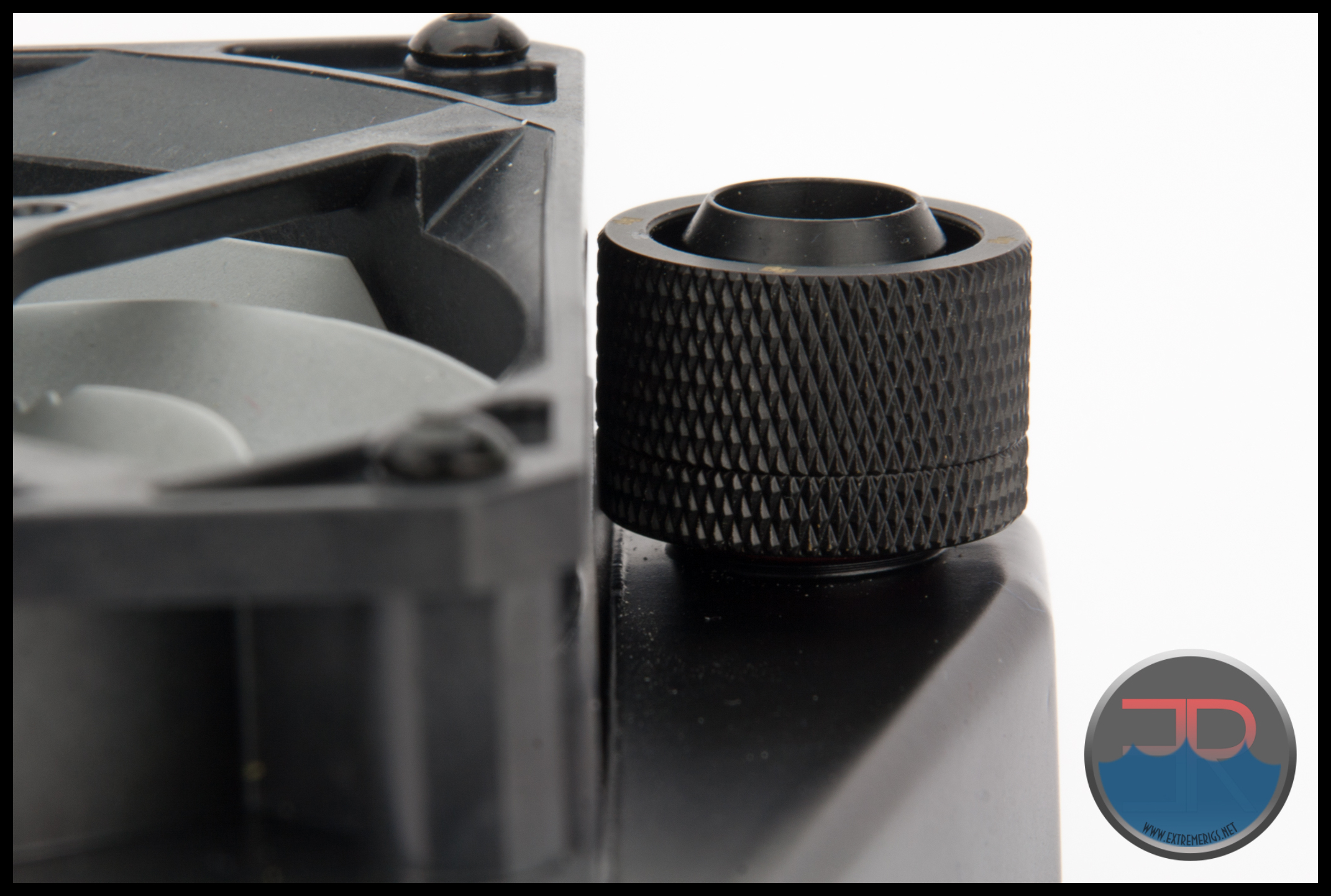 Screw protection plates are fitted under the M3 threaded mounting holes. Protection Plates are a feature we wish all manufacturers would incorporate. Even though screws are provided that can not puncture the core (short threads & thick shanks), Alphacool continue to provide the extra insurance by installing plates on all of the NexXxos series radiators.
Screw protection plates are fitted under the M3 threaded mounting holes. Protection Plates are a feature we wish all manufacturers would incorporate. Even though screws are provided that can not puncture the core (short threads & thick shanks), Alphacool continue to provide the extra insurance by installing plates on all of the NexXxos series radiators.
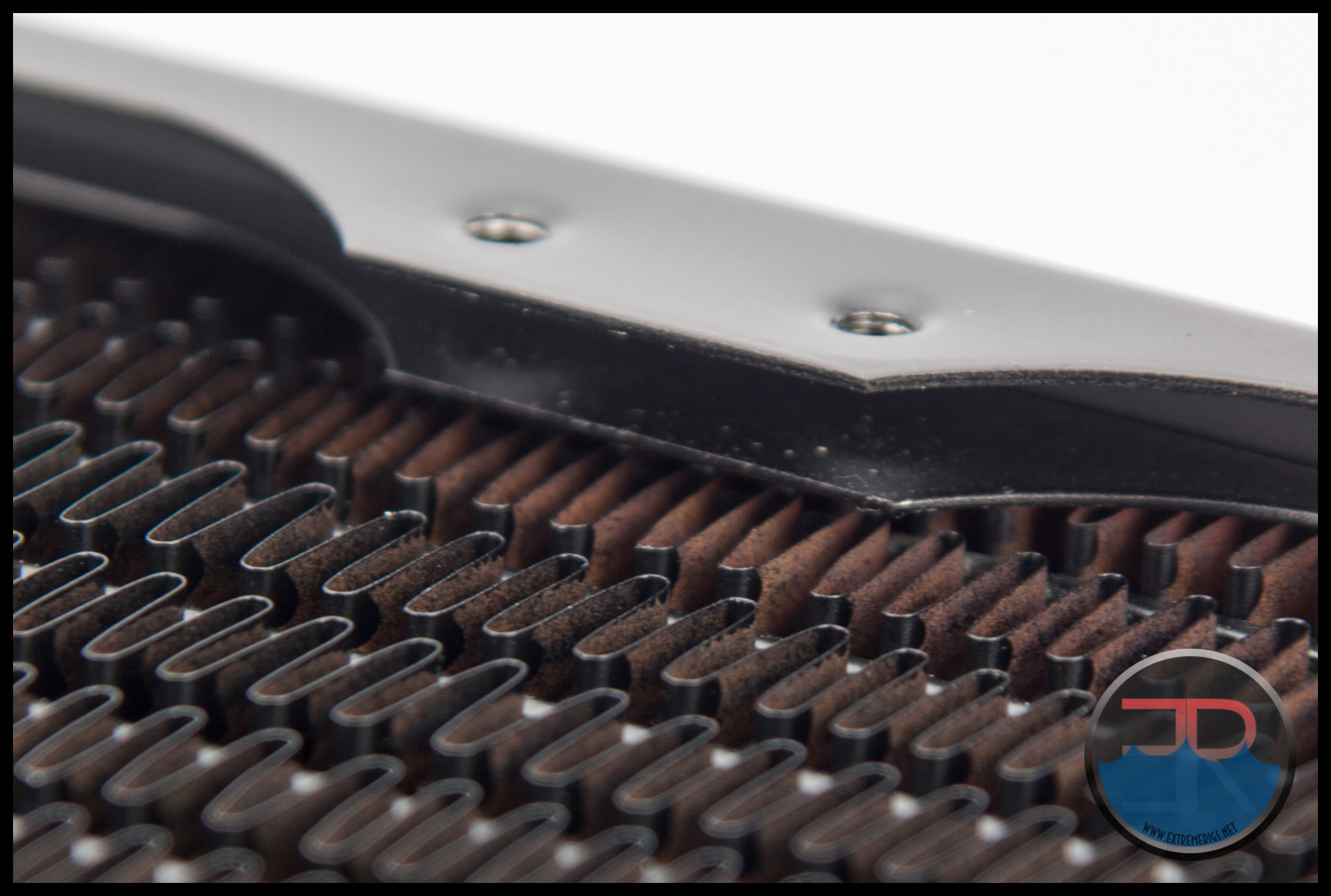 We are glad the ST30 has the protection plates as a back-stop because the outside tubes are located directly under the screw holes.
We are glad the ST30 has the protection plates as a back-stop because the outside tubes are located directly under the screw holes.
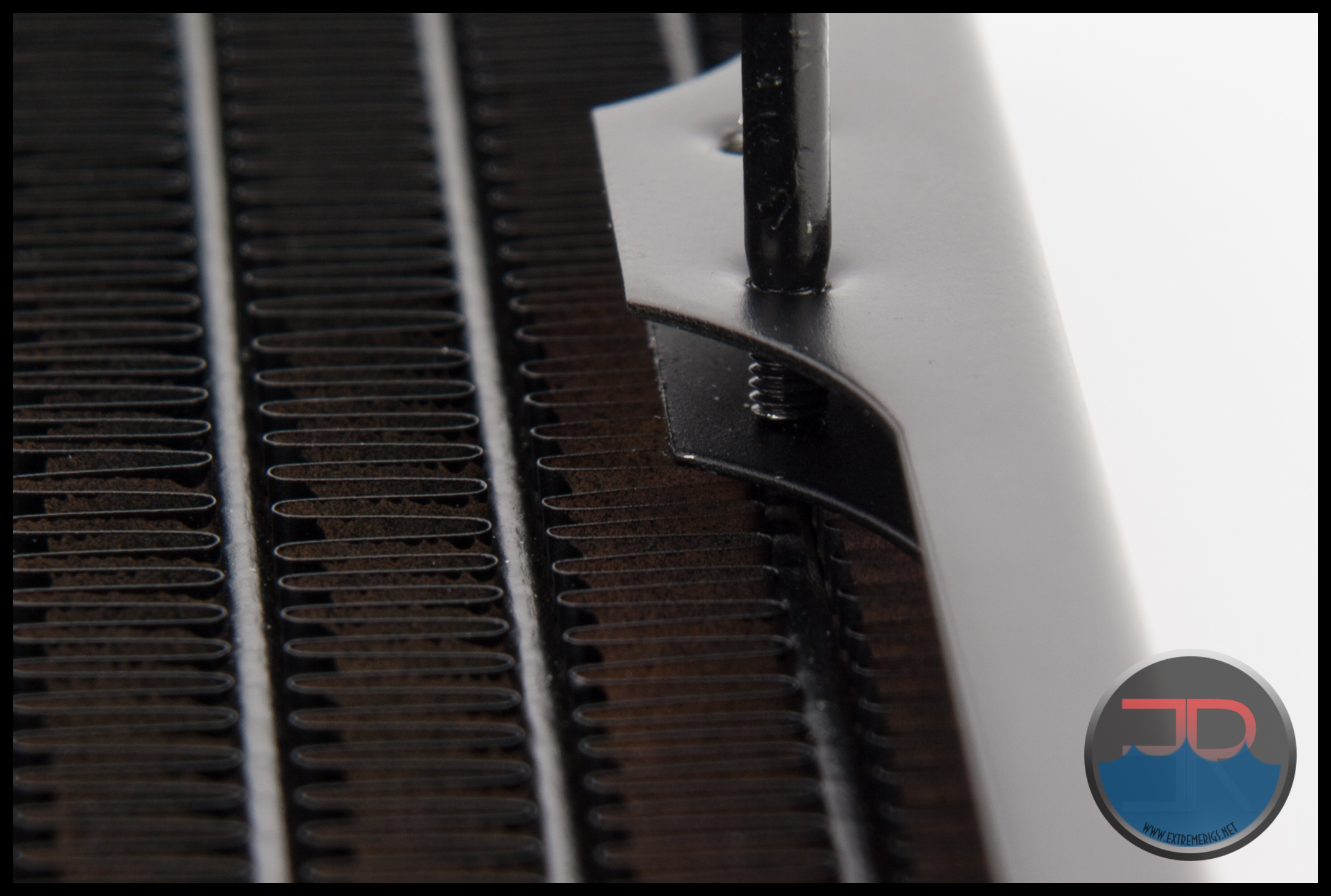 The inbuilt shroud depth is ~7mm to the fins (~6mm to protection plates) on both faces of the ST30 X-Flow.
The inbuilt shroud depth is ~7mm to the fins (~6mm to protection plates) on both faces of the ST30 X-Flow.
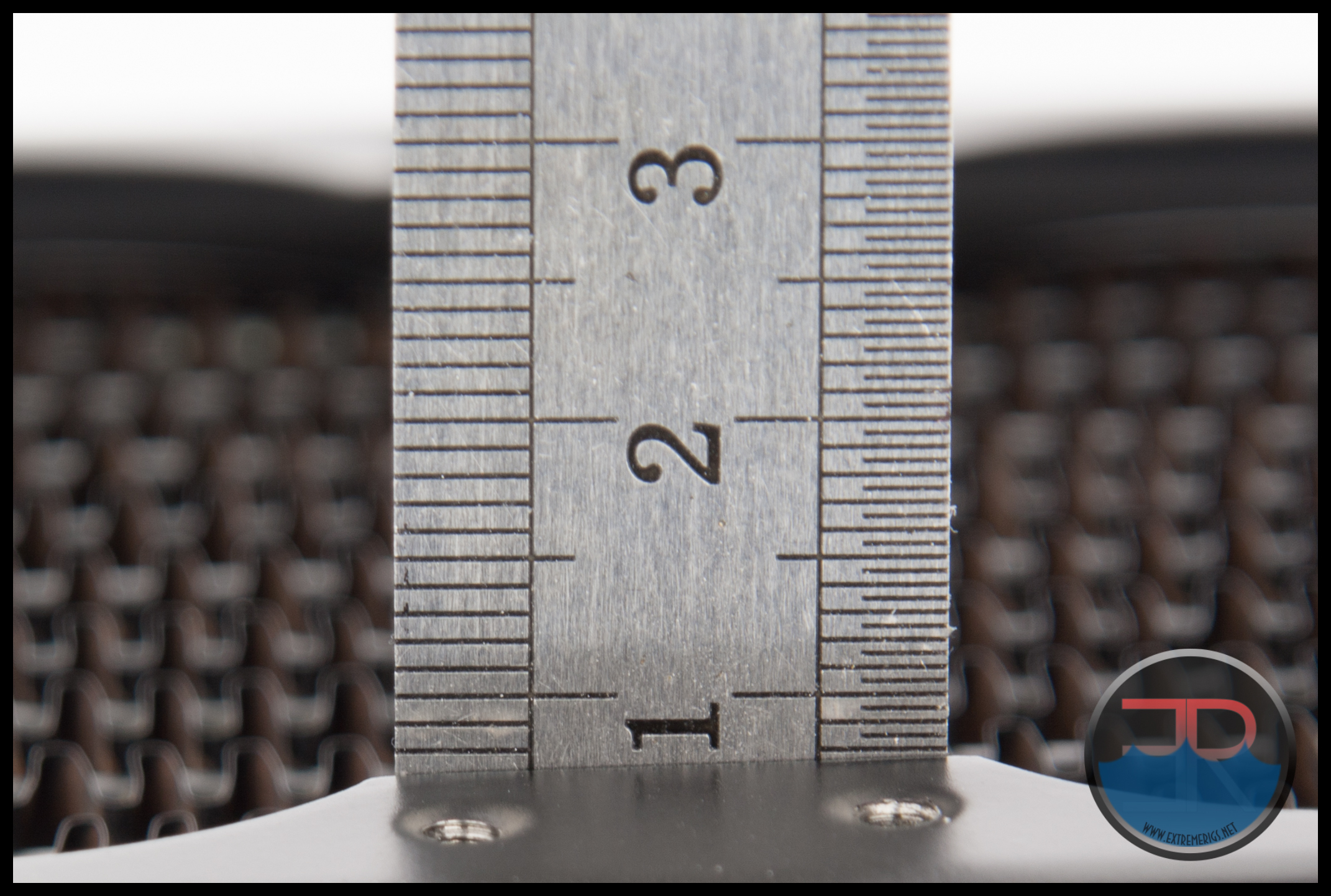 When a standard 25mm thick fan is fitted using the supplied 30mm length screws, the bottom of the screws are still well clear (~2mm) of the protection plates.
When a standard 25mm thick fan is fitted using the supplied 30mm length screws, the bottom of the screws are still well clear (~2mm) of the protection plates.
The 15mm fan spacing is perfect.
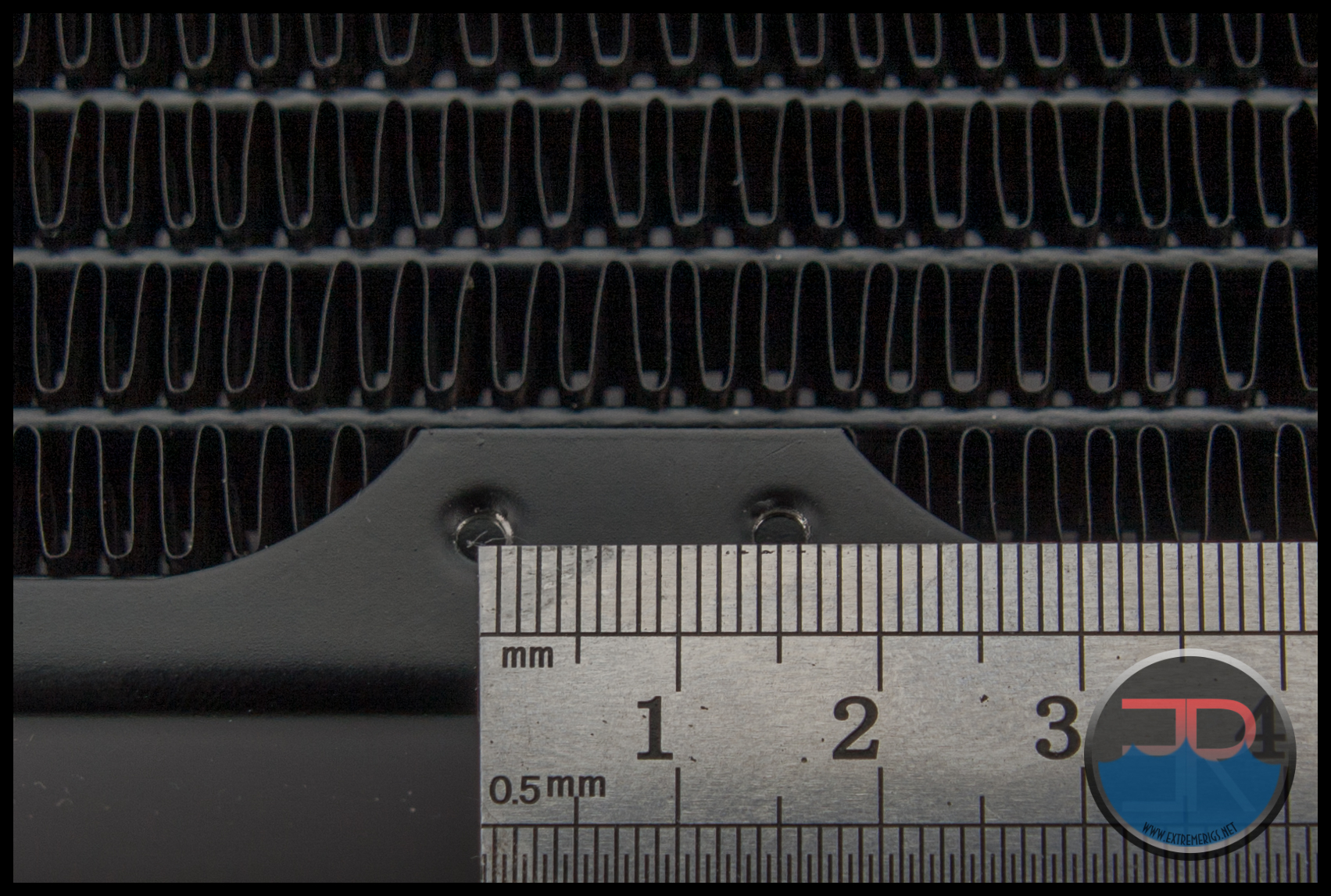 As we have seen a few of radiators with poorly located fan mounting holes, we also take these measurements to check that specs are being adhered to during manufacturing.
As we have seen a few of radiators with poorly located fan mounting holes, we also take these measurements to check that specs are being adhered to during manufacturing.
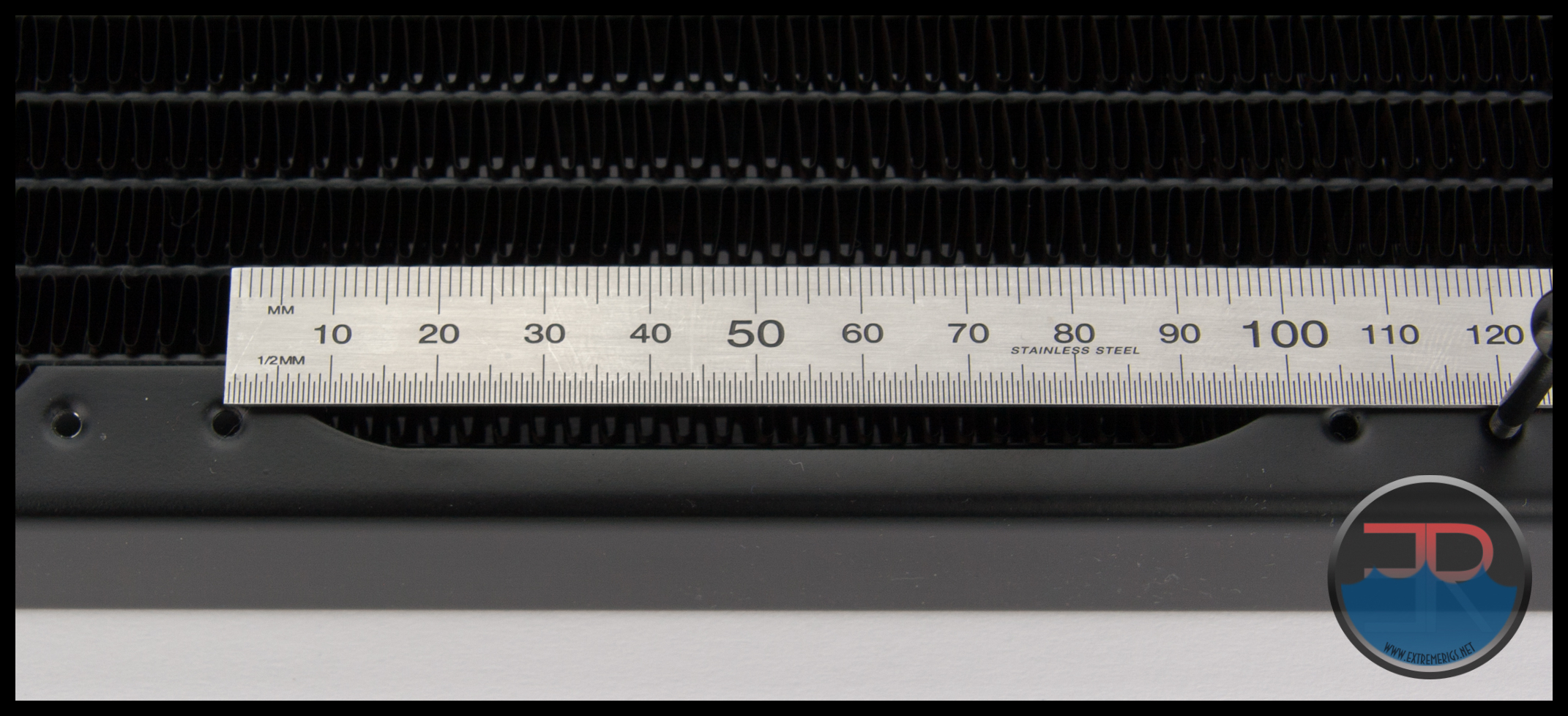 105mm spacing for the fan mounts were perfect also, both length-ways and across the ST30 X-Flow.
105mm spacing for the fan mounts were perfect also, both length-ways and across the ST30 X-Flow.
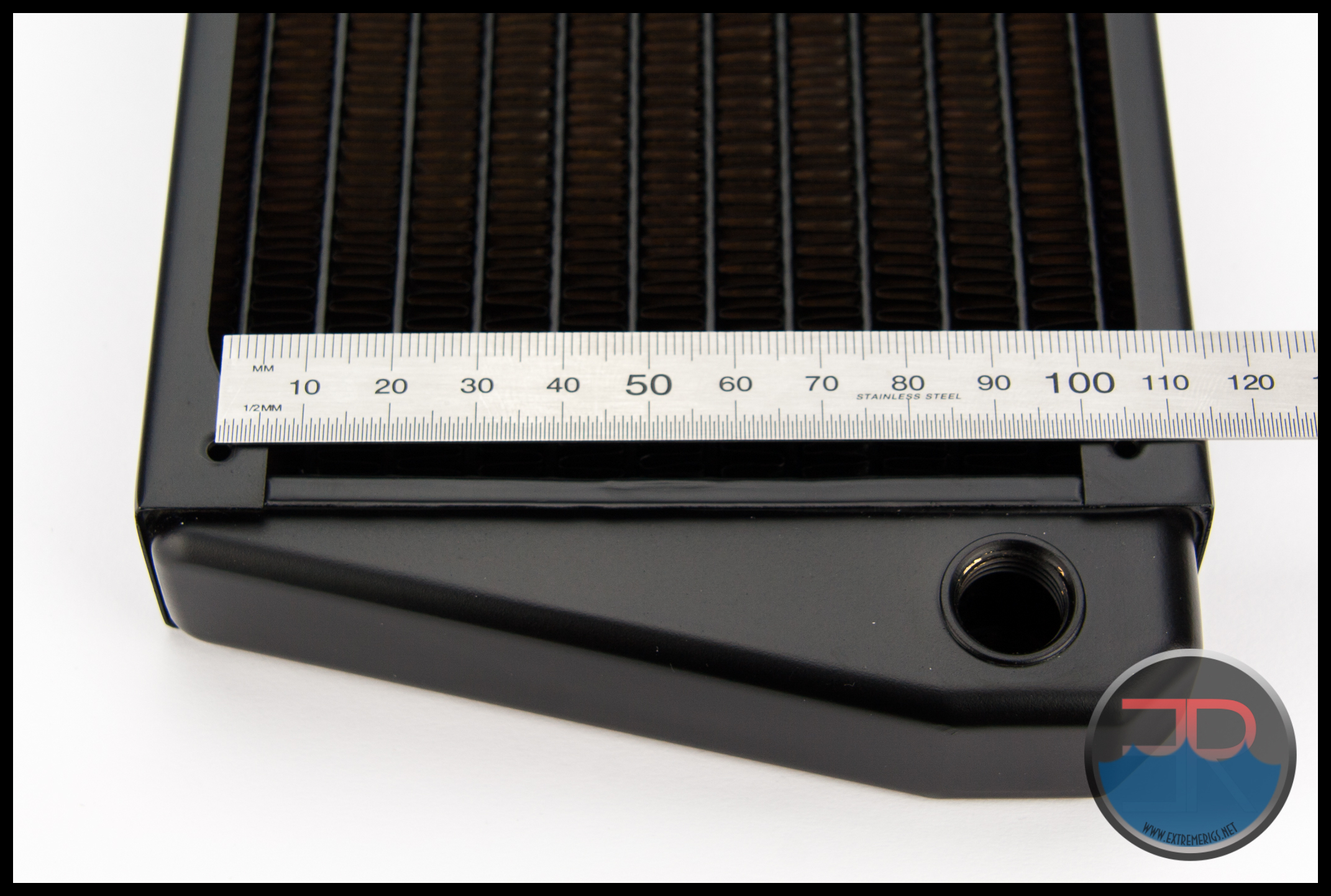 Given all the fan hole measurements were good, we had no dramas attaching 120mm fans to the ST30 X-Flow.
Given all the fan hole measurements were good, we had no dramas attaching 120mm fans to the ST30 X-Flow.
The ST30 X-Flow is a slim 360mm radiator with a single pass, X-Flow coolant path and has 2 ports on each end tank. The medium density fin array between reasonably thick 1.9mm tubes should equate to very low restriction levels and we expect it to perform quite well with medium speed fans. The tank design is good and overall the radiator feels solidly built. The paint finish and build quality is great, however painting the port threads is a practice which annoys us. So far so good.
Let’s see how it performs…

Flow Rate Testing
The Data
As all our testing for 360mm radiators are performed with the exact same equipment, using the exact same methods we have decided to (try and) keep each radiator’s pages uncluttered by posting our testing methodology, test set-ups and equipment used in a single location. To see exactly how the tests were carried out, details of the test set ups and equipment used, please check out the RRU Test Setup page.
Restriction Test
It is generally agreed that radiators are one of, if not the least restrictive components in the water cooling loop. There are some exceptions however, so this must still be verified through testing:
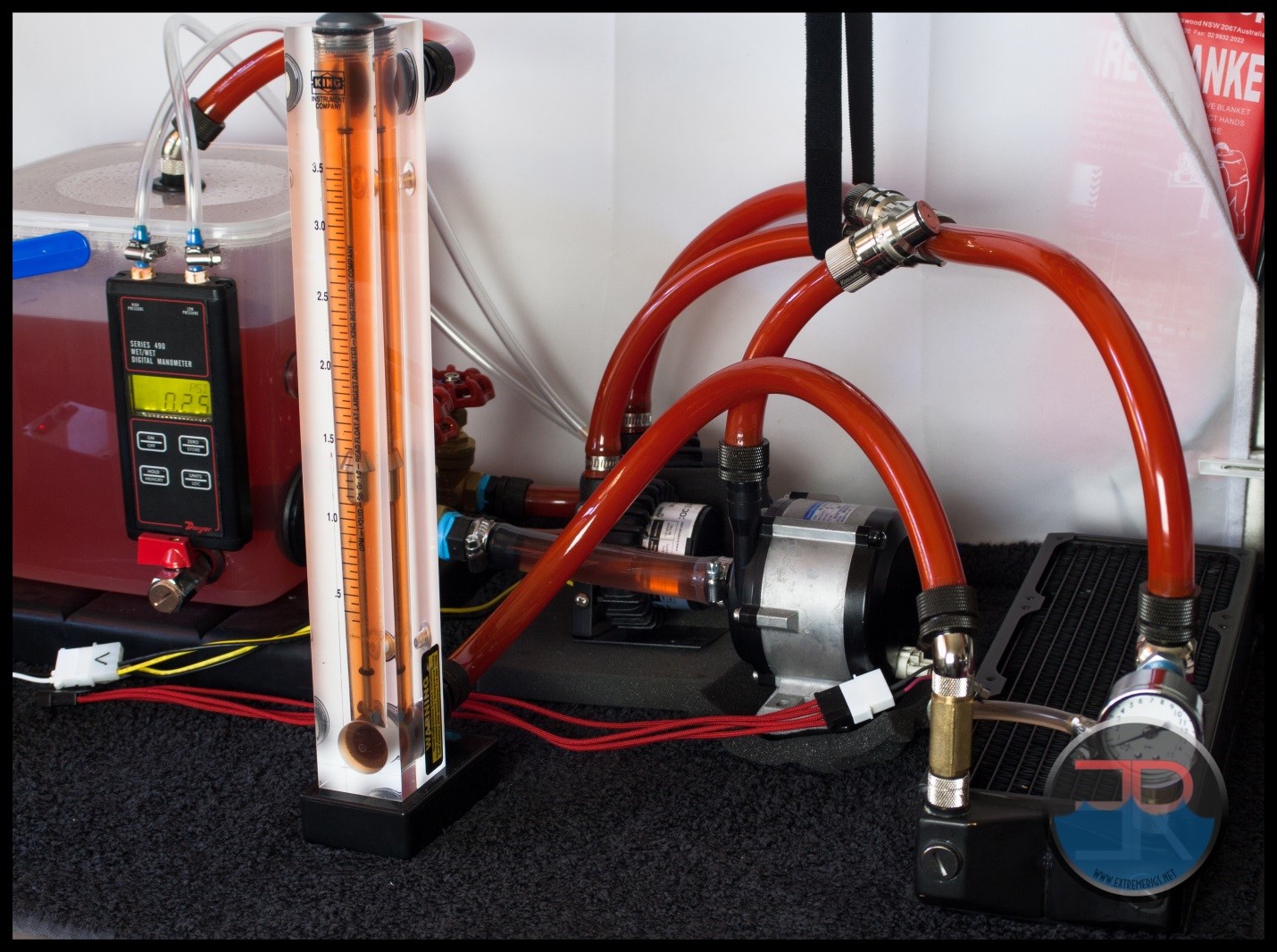 The above photo is for referencing the restriction test bench. The ST30 X-Flow is not loaded so please disregard the data in the picture as it does not relate to the its test results.
The above photo is for referencing the restriction test bench. The ST30 X-Flow is not loaded so please disregard the data in the picture as it does not relate to the its test results.
Here is the raw data at the tested flow rates, displaying the measured Differential Pressure across the radiator as flow rate was increased.
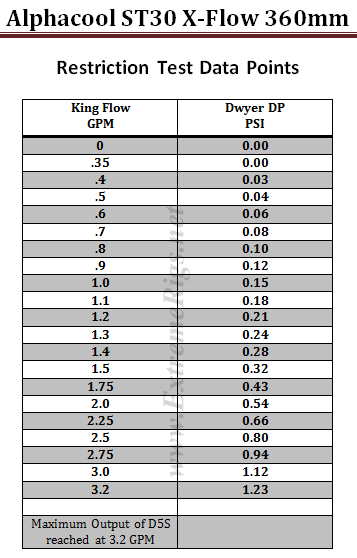 The table numbers indicate that the ST30 X-Flow is a very low restriction radiator. In fact our differential pressure manometer was unable to detect a difference at the lowest flow rate on the flow meter. Numbers in isolation sometimes only tell half the story. By plotting against other components it more easily shows the whole story.
The table numbers indicate that the ST30 X-Flow is a very low restriction radiator. In fact our differential pressure manometer was unable to detect a difference at the lowest flow rate on the flow meter. Numbers in isolation sometimes only tell half the story. By plotting against other components it more easily shows the whole story.
We use a HeatKiller 3.0 CPU block as the reference in this next plot for two reasons. Firstly there is little chance of the plot being cluttered by curves overlapping and secondly it gives a reference point against a fairly common loop component of average restriction.
As with all previous radiator restriction plots, we have limited the maximum flow rate displayed to 2.0 GPM as we suspect there are very few systems that operate above 2.0 GPM. For more information on how to read a restriction plot check out our guide.
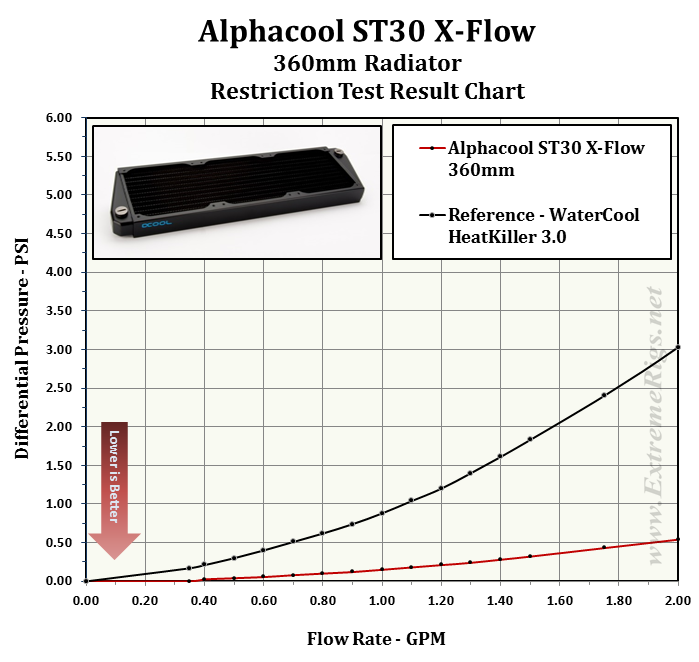 This plots indicates the ST30 X-Flow is a very low restriction loop component when compared to a CPU block of average restriction, but what about other radiators?
This plots indicates the ST30 X-Flow is a very low restriction loop component when compared to a CPU block of average restriction, but what about other radiators?
The next three plots show the restriction level at three different flow rates compared to the other Slim 360mm radiator that have been tested. We consider the chosen GPM rates to represent systems which have low, medium and high flow rates. Additionally, a plot has been included which shows the comparison against all the radiators that have been on our restriction test bench.
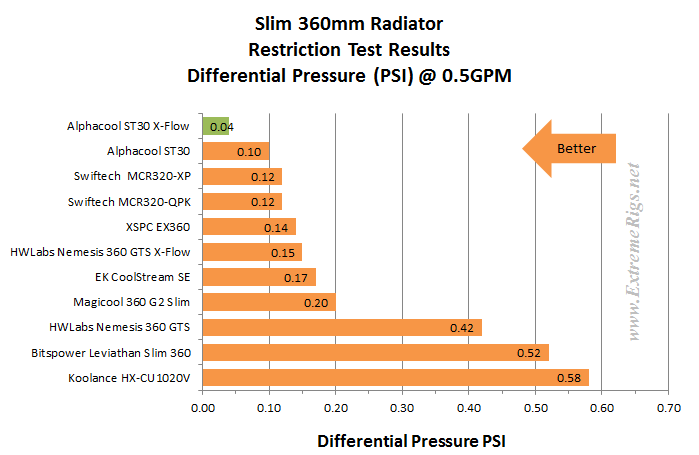 As it turns out the ST30 X-Flow and the regular ST30 360mm models share the exact same core with only slight differences for manufacturing tolerances. Therefore with the same amount of tubes which are the same thickness we expect to see the X-Flow pressure readings to be “almost” exactly half of the standard ST30.
As it turns out the ST30 X-Flow and the regular ST30 360mm models share the exact same core with only slight differences for manufacturing tolerances. Therefore with the same amount of tubes which are the same thickness we expect to see the X-Flow pressure readings to be “almost” exactly half of the standard ST30.
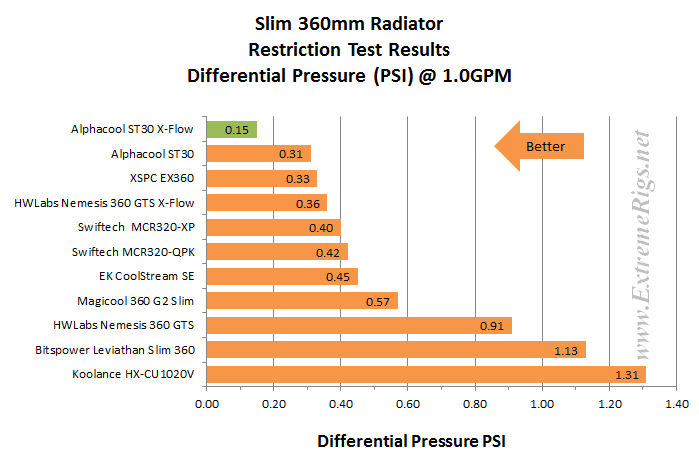
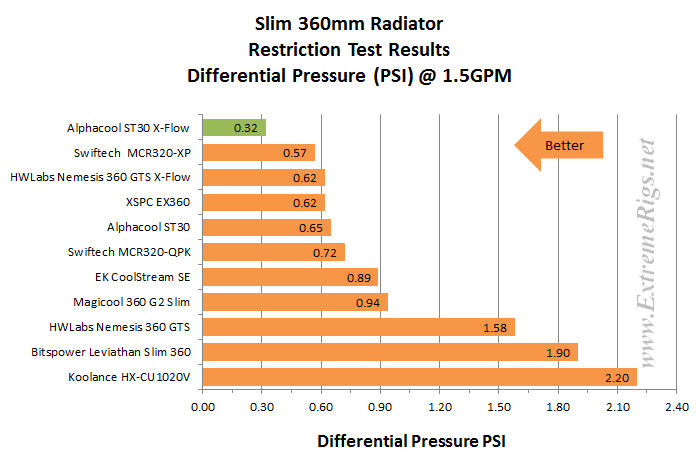 We expected the ST30 X-Flow to record low restriction reading because it is a X-Flow radiator and that is exactly what we found. At all 3 flow rates plotted, it has the lowest restriction level of all the slim 360 radiators.
We expected the ST30 X-Flow to record low restriction reading because it is a X-Flow radiator and that is exactly what we found. At all 3 flow rates plotted, it has the lowest restriction level of all the slim 360 radiators.
We know the the Nemesis GTS X-Flow has a more restrictive flow path than the ST30 X-Flow because it has more tubes which are also thinner, but we thought it interesting to isolate the 2 models and plot them against each other.
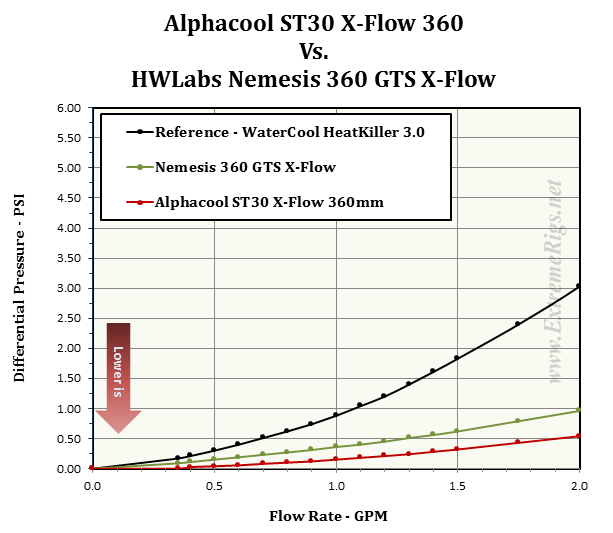
Finally for restriction let’s take a look at where the ST30 X-Flow 360mm fits in relation to all the radiators we have tested. For this plot, only results for 1.0 GPM have been used for the comparison.
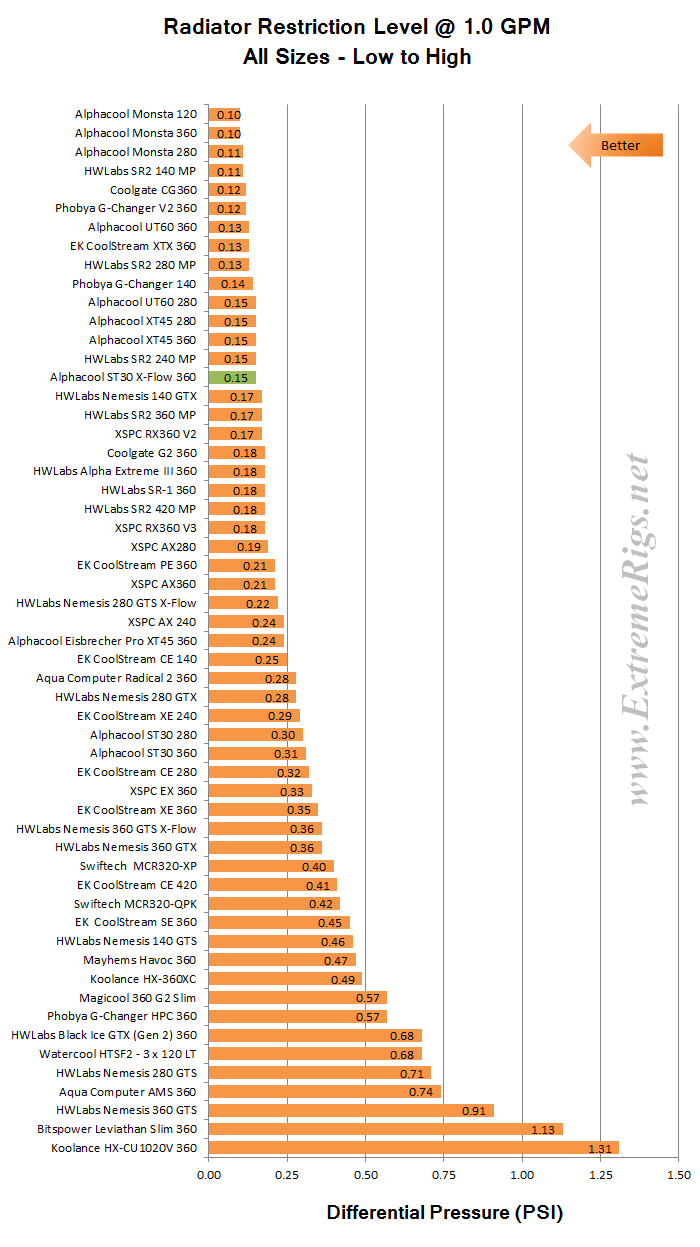 When put into context with all the radiators at 1.0 GPM, the ST30 X-Flow fits our criteria for a low restriction radiator. This means pump power is not high on the list of considerations, even if you’re intending to run several of them in your loop.
When put into context with all the radiators at 1.0 GPM, the ST30 X-Flow fits our criteria for a low restriction radiator. This means pump power is not high on the list of considerations, even if you’re intending to run several of them in your loop.
Onwards to Thermal Performance!

Thermal Testing
The Thermal Data
Moving on from the restriction bench the ST30 X-Flow was loaded into the thermal chamber for a series of 6 tests conducted at 1.0 GPM with Push/Pull fans and Push Only, each having 3 different fan rpm speeds tested.
Below is the final data results gathered from at least 5 data logging runs at each fan rpm. The most stable 15 minute period from each logging run was used and then averaged with the other runs to obtain the data for the table below. A total of 16 temperature sensors were used in the thermal test chamber (8 air in, 2 air out, 3 water in, 3 water out). Each sensor takes a reading every second and logged via a CrystalFontz unit. The data in the table below is the averaged results of the logging runs which has then been used to create all the plots and tables there-after.
NOTE: Since our massive Radiator Round Up was completed, the thermal testing rig was retired and parts pulled from it for use in other projects. However, the rig was recommissioned for this review and one other, but after several days testing we were unable to get the same calibration on the rig as in the past. Therefore we are not able to compare (apples to apples) these recent results with data previously recorded. Because of this we re-tested a couple of radiators with the new calibration so that we do have some results to compare the ST30 X-flow against. As we were changing the testing comparison we decided to reduce the large number of hours spent data logging by focusing solely on 1GPM flow rates. This would streamline the extensive testing process by about 50%.
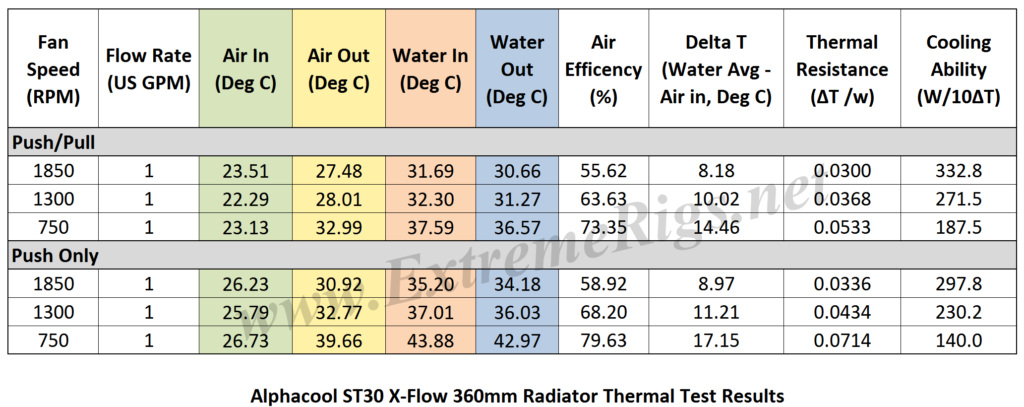 A performance metric of critical importance is the delta between the warm coolant temperature and the cool ambient air temperature going into the radiator. Given that the system is well insulated, in equilibrium and we know the heat input to the system then we can also calculate some other very important numbers. The most useful for the end user is the amount of power being dissipating from the coolant during it’s pass through the radiator. That amount is what we refer to as Cooling Ability and is typically displayed with 1°C or 10°C Delta T as a reference point. The latter being more useful and is a good target for users to aim for when testing their loop. This W/10DT or W/10ΔT is the calculation used for our thermal performance assessments and comparisons.
A performance metric of critical importance is the delta between the warm coolant temperature and the cool ambient air temperature going into the radiator. Given that the system is well insulated, in equilibrium and we know the heat input to the system then we can also calculate some other very important numbers. The most useful for the end user is the amount of power being dissipating from the coolant during it’s pass through the radiator. That amount is what we refer to as Cooling Ability and is typically displayed with 1°C or 10°C Delta T as a reference point. The latter being more useful and is a good target for users to aim for when testing their loop. This W/10DT or W/10ΔT is the calculation used for our thermal performance assessments and comparisons.
Let’s take a look at the Delta T results from the tests, firstly plotted with extrapolation and followed by a bar chart. Note that the extrapolation of the curve is much more sensitive to error than in the tested range. With the omitted flow rate testing what we have here is essentially a DeltaT comparison of Push Only Vs. Push/Pull at 1.0 GPM.
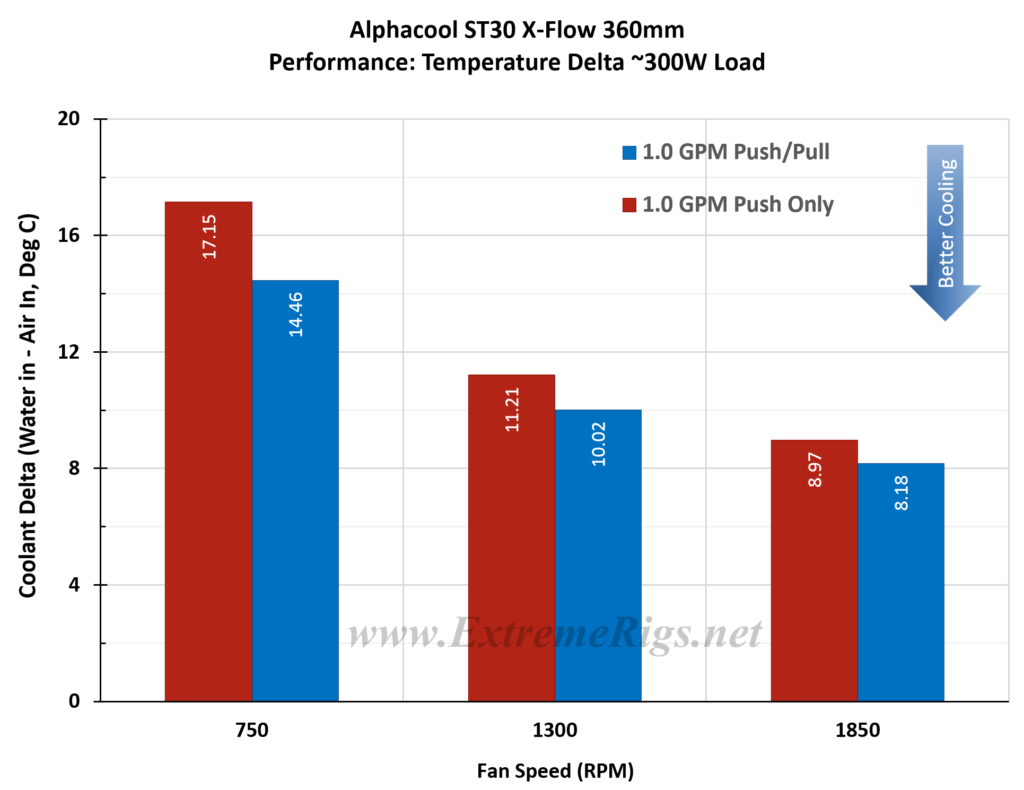 I was not too concerned about the actual delta number results, but instead the trend pattern. As expected the deltas come down significantly as the fan speed is increased.
I was not too concerned about the actual delta number results, but instead the trend pattern. As expected the deltas come down significantly as the fan speed is increased.
Delta T results (as above) are not always helpful when thinking about how many radiators you would need to cool your system. Instead it’s more useful to know the metric of W/Delta C. This metric is plotted below. It tells us how many Watts are dissipated by the radiator when the coolant rises 10C above ambient temperatures (W/10ΔT).
This same data can now be plotted on a chart so that an end user can interpolate their own fan speed. Note again that the extrapolation of the curve is much more sensitive to error than in between the tested range.
As the sampling was reduced to only 1.0 GPM we don’t have the different flow rate comparisons in Push/Pull, but we do have the data to compare the Push Only Vs. Push/Pull in an “apples to apples” fashion by only looking solely at the 1.0 GPM data:
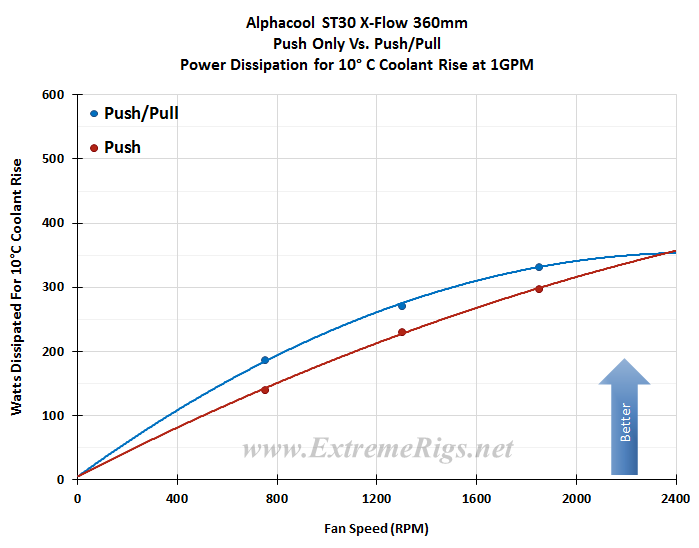 The average difference between Push Only and Push/Pull results at the same fan speed was ~11%, and ranged from ~8% at 1850 rpm to ~14% at 750 rpm. These are decent percentage increases for a slim radiator, though the end result is probably not great enough to recommend Push/Pull for this or any other slim 360mm radiator.
The average difference between Push Only and Push/Pull results at the same fan speed was ~11%, and ranged from ~8% at 1850 rpm to ~14% at 750 rpm. These are decent percentage increases for a slim radiator, though the end result is probably not great enough to recommend Push/Pull for this or any other slim 360mm radiator.
Of interest with the extrapolated curves in the above chart is that the Push/Pull curve has all but flattened out by 2400 RPM indicating it’s peak performance has almost been reached. On the other hand Push Only would (in theory) continue to improve if the fan speed (air volume and pressure) could be increased.
Let’s analyze that data some more…
Data Analysis
Again Please NOTE: Since our massive Radiator Round Up was completed, the thermal testing rig was retired and parts pulled from it for use in other projects. However, the rig was recommissioned for two reviews, but after several days testing we were never able to get the same calibration on the rig. Therefore we are not able to compare (apples to apples) these recent results with data previously recorded. Because of this we re-tested a couple of radiators with the new calibration so that we do have some results to compare the ST30 X-flow against. However in order to save time with these retests we streamlined the testing and stripped out the 0.5GPM and 1.5GPM Push/Pull tests.
This table shows the ST30 X-Flow’s W/10ΔT numbers at 1GPM in a quick glance chart format.
We have striven from the beginning of our radiator testing to achieve a test error margin of 1% or less. Initially we ran tests for months to verify data was accurate and repeatable before we commenced testing to publish the results. With our test equipment and methodology we believe we produce the most accurate data available for PC radiator thermal dissipation.
Push Only Data vs Competition
Focusing on the Push Only results for now, we’ll get to the Push/Pull data later. Keep in mind that the ST30 is the only radiator of the group that we should really compare against as the others have cores which are twice as thick.
Let’s start with 750 RPM and see how the ST30 X-Flow compares.
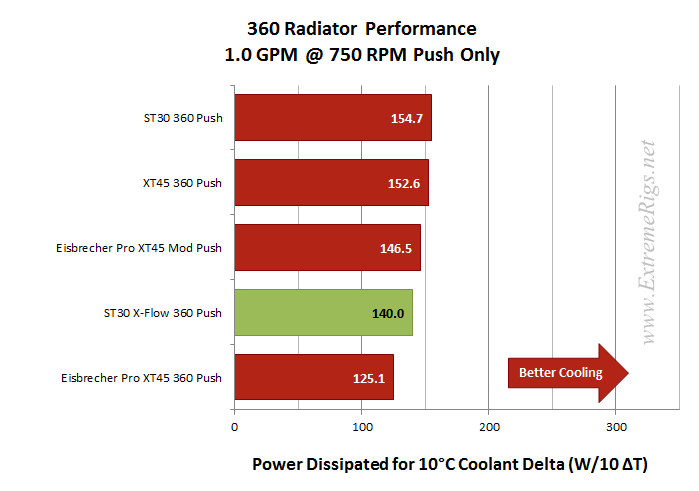 The ST30 X-Flow finished in the lower half of our small test field for Push Only at 750 RPM. The regular ST30 was the winner being ~9.5% ahead of the X-Flow at this data point.
The ST30 X-Flow finished in the lower half of our small test field for Push Only at 750 RPM. The regular ST30 was the winner being ~9.5% ahead of the X-Flow at this data point.
One challenge a X-Flow radiator faces is keeping the fluid turbulent in the tubes. This can be achieved by using thinner tubes, however the ST30 X-Flow tubes are 1.9mm wide which is a pretty standard size, in fact the same size as the regular ST30. If the flow rate through the tubes in not sufficient, the flow could become laminar. Laminar means that the fluid is running parallel or straight through the tubes and only the coolant in direct contact with the tubes is being cooled effectively. We want turbulent flow at all times where the coolant is mixing around as it passes through the tubes.
We have no way of knowing for sure how the coolant is interacting (or not) within the tubes, but it may offer an explanation for the results we are seeing here. Remember that a 1.0 GPM system flow rate equates to 0.5 GPM flow rate through a X-Flow radiator, assuming it has a single layer core such as the ST30 X-Flow.
Again we have no evidence of laminar flow being an issue here, but it is possible and something to keep in mind particularly if you run low flow rate systems do to lack of pump power, running pump at low rpm, or have a very restrictive loop.
Another simplistic way to think about an x-flow version of a radiator is that the coolant spends less time in the radiator for the same flow rate. This means that at high air flow the difference should be minimal in performance because the coolant is already fully cooled to ambient before it leaves the radiator. However this might imply that a radiator with shorter flowpath is better – but as we already see in this data the performance is lower at low air speeds. At lower air speeds the coolant is not fully cooled so the more time it spends in the radiator the more cool it gets. There is some optimal balance in the amount of time the coolant should spend in the radiator and that will vary with air flow and coolant flow rate. Most manufacturers have gone with a a dual pass design, while other x-flows and quad and hex pass radiators designs have shown that other designs can work with similar results.
Now let’s look at 1300 rpm:
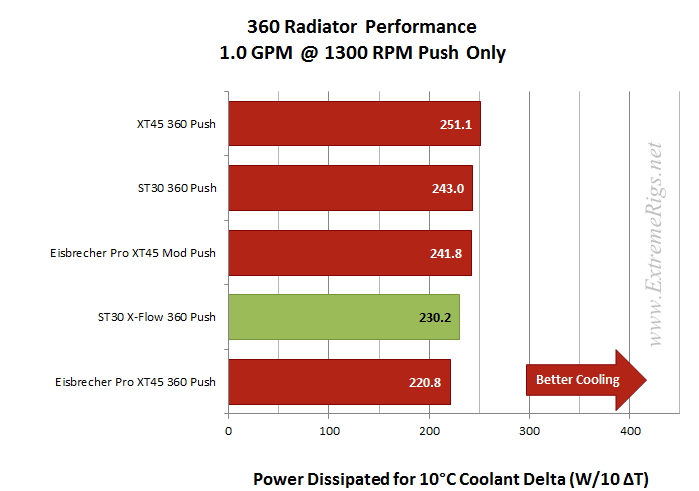 For Push Only 1300 RPM again the ST30 X-Flow is in the lower half of the pack. The regular ST30 has relinquished it’s lead and is now just ~5% ahead of the X-Flow version.
For Push Only 1300 RPM again the ST30 X-Flow is in the lower half of the pack. The regular ST30 has relinquished it’s lead and is now just ~5% ahead of the X-Flow version.
Now 1850 rpm Push Only:
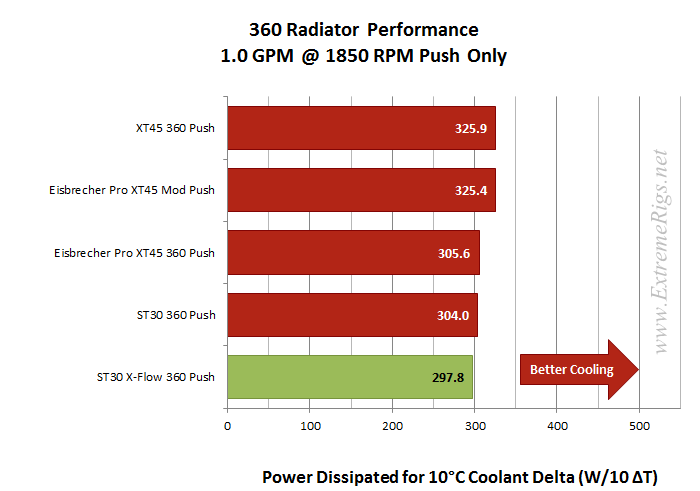 At 1850 RPM the ST30 X-Flow places last but is now only ~2% behind the regular ST30. The other 2 radiators are both 45mm thick so we didn’t want to comment on comparisons against them, but you may have noticed in the 750 RPM and 1300 RPM plots that the ST30 X-Flow was ahead of the thicker and much more expensive Eisbrecher Pro. We have our theories on the poor Eisbrecher performance and will no doubt be discussed in our upcoming Eisbrecher Pro review.
At 1850 RPM the ST30 X-Flow places last but is now only ~2% behind the regular ST30. The other 2 radiators are both 45mm thick so we didn’t want to comment on comparisons against them, but you may have noticed in the 750 RPM and 1300 RPM plots that the ST30 X-Flow was ahead of the thicker and much more expensive Eisbrecher Pro. We have our theories on the poor Eisbrecher performance and will no doubt be discussed in our upcoming Eisbrecher Pro review.
While not a stand out performer in then Push Only comparisons, the ST30 X-Flow did produce acceptable results, and it’s comparative performance against the same thickness radiator improved as the fans speeds increased. This matches our expectations.
One more chart to share for Push Only. Here we have plotted the ST30 X-Flow against the ST30 and XT45 at 1.0 GPM.
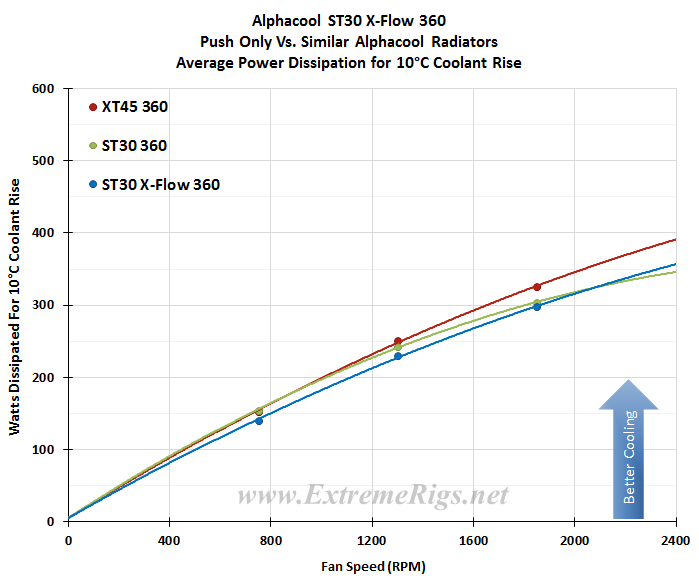 This shows us that for all the Push Only fan speeds we tested at 1.0 GPM the ST30 X-Flow is really not too far off the pace.
This shows us that for all the Push Only fan speeds we tested at 1.0 GPM the ST30 X-Flow is really not too far off the pace.
Now let’s find out how it performs with Push/Pull fans.
Push/Pull is the most unlikely installation scenario for the ST30 X-Flow. It’s a set-up which we would not recommend using for any Slim radiator. The benefits of Push/Pull on a slim rad aren’t great enough to warrant the extra space and cost required for the additional fans. If you have 80mm of space available (slim rad + 2 fans) we would advise investigating a thicker radiator with a Push Only fan assembly.
Push/Pull Data vs. Competition
Again only the 1.0 GPM comparison results are being displayed due to the trimmed down testing regime that was implemented.
Firstly the 750 rpm:
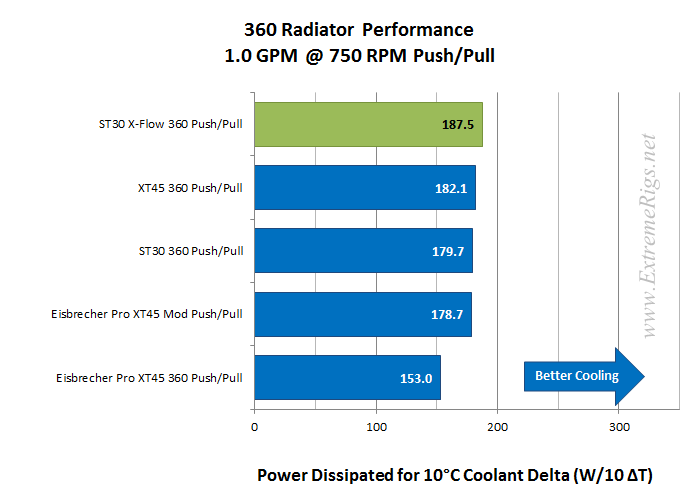 The ST30 X-Flow places 1st in the Push/Pull low fan speed beating not only the regular ST30 but also the thicker XT45. This seems to be a sweet spot for the X-Flow. While the single pass definitely seems to be working in the ST30 X-Flow’s favor at this data point we did not expect the X-Flow to out perform the regular ST30. However the radiator test rig has sometimes produced some unexpected results that were repeatable and consistent at this one test point. The HWLabs “Optiflow” vs Reverse flow come to mind – results that theory say should perform worse but at only this one data point perform better. With a 4% delta between the two results it is larger than the expected margin of error and it is repeatable so we do not believe that it is simply error. As we mentioned before there is an optimal amount of time for the coolant to be in the radiator for each combination of air and coolant flow rate. Perhaps this just happens to be the most optimal for the x-flow.
The ST30 X-Flow places 1st in the Push/Pull low fan speed beating not only the regular ST30 but also the thicker XT45. This seems to be a sweet spot for the X-Flow. While the single pass definitely seems to be working in the ST30 X-Flow’s favor at this data point we did not expect the X-Flow to out perform the regular ST30. However the radiator test rig has sometimes produced some unexpected results that were repeatable and consistent at this one test point. The HWLabs “Optiflow” vs Reverse flow come to mind – results that theory say should perform worse but at only this one data point perform better. With a 4% delta between the two results it is larger than the expected margin of error and it is repeatable so we do not believe that it is simply error. As we mentioned before there is an optimal amount of time for the coolant to be in the radiator for each combination of air and coolant flow rate. Perhaps this just happens to be the most optimal for the x-flow.
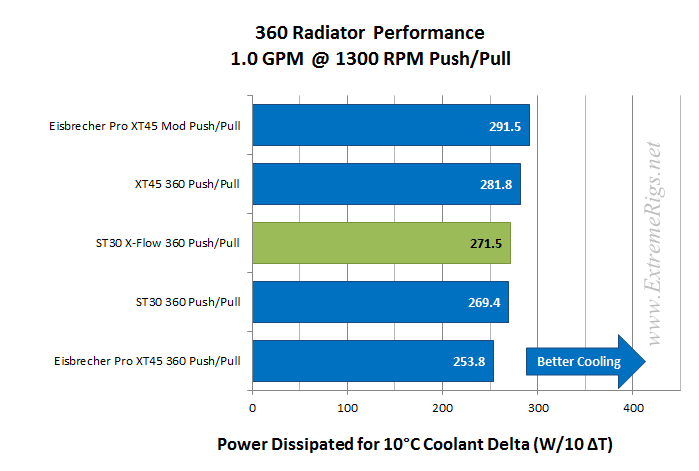 At 1300 RPM Push/Pull the regular ST30 has gained ground on the X-Flow where they are now virtually equal. This bring us back to the idea that at high enough airflows these two radiators should perform identically.
At 1300 RPM Push/Pull the regular ST30 has gained ground on the X-Flow where they are now virtually equal. This bring us back to the idea that at high enough airflows these two radiators should perform identically.
Now 1850 rpm:
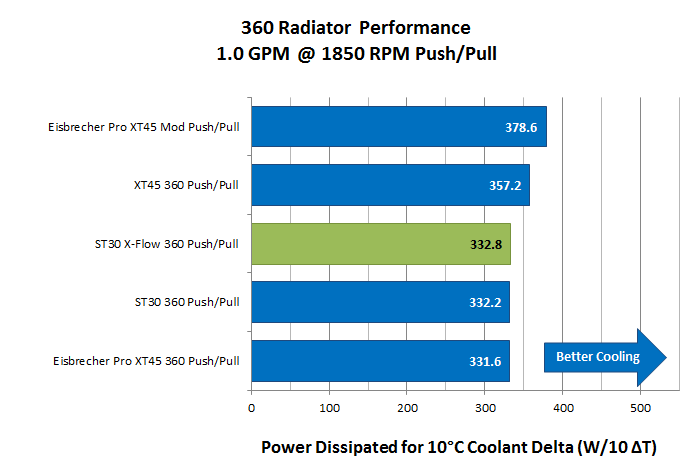 I have to admit I find very the above chart very interesting when we compare the ST30 and ST30 X-Flow. Remembering that they both have an identical cooling package (core) and only the flow path through them is different. The X-Flow’s single pass slight advantage with low fan speeds has disappeared now and we can safely say that the two models have equal cooling potential at this data point.
I have to admit I find very the above chart very interesting when we compare the ST30 and ST30 X-Flow. Remembering that they both have an identical cooling package (core) and only the flow path through them is different. The X-Flow’s single pass slight advantage with low fan speeds has disappeared now and we can safely say that the two models have equal cooling potential at this data point.
We think this gives validity to the other test point’s data even though they may have seemed unusual at times. As the rig was calibrated identically for each radiator we see matching results for the same core as it approaches it’s cooling capacity, even though it is on different models with completely different flow paths.
Lastly for Push/Pull we have again plotted the ST30 X-Flows results against some of it’s fellow Alphacool stable mates.
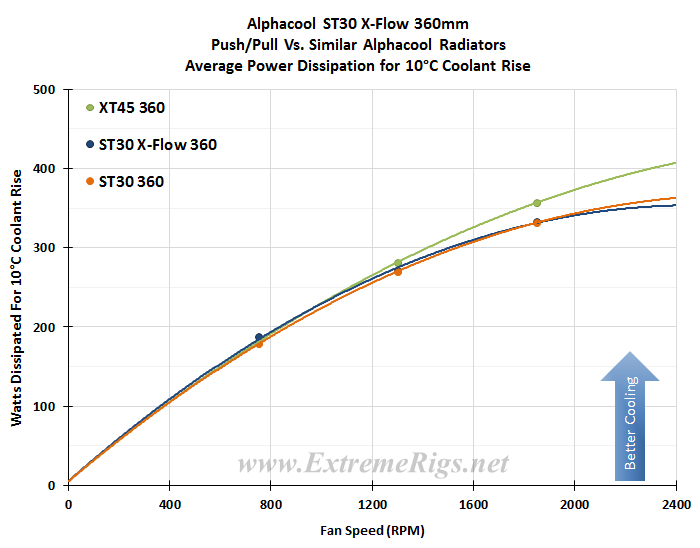 While we saw some separation in the Push Only plot, here we see the X-Flow going toe-to-toe with regular ST30 and the XT45 only gains any real advantage with high fan speeds.
While we saw some separation in the Push Only plot, here we see the X-Flow going toe-to-toe with regular ST30 and the XT45 only gains any real advantage with high fan speeds.
Let’s now place the data for Push Only and Push/Pull at 1.0 GPM for each fan speed together so we see both sets of results on the same plot. Sometimes these combined plots show up some points of interest even though it is a repeat of data we have already looked at separately.
Again the 750 rpm first:
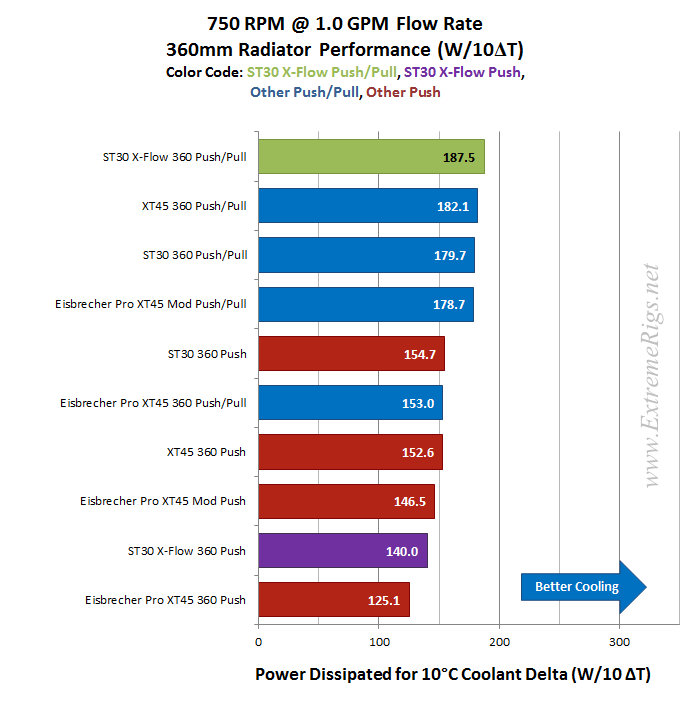 It is a small test group of just five radiators so perhaps the results here are exaggerated somewhat, but these plots really can show a radiator’s strengths and weaknesses. In the above plot for example the ST30 X-Flow has a 1st place and a 2nd last place.
It is a small test group of just five radiators so perhaps the results here are exaggerated somewhat, but these plots really can show a radiator’s strengths and weaknesses. In the above plot for example the ST30 X-Flow has a 1st place and a 2nd last place.
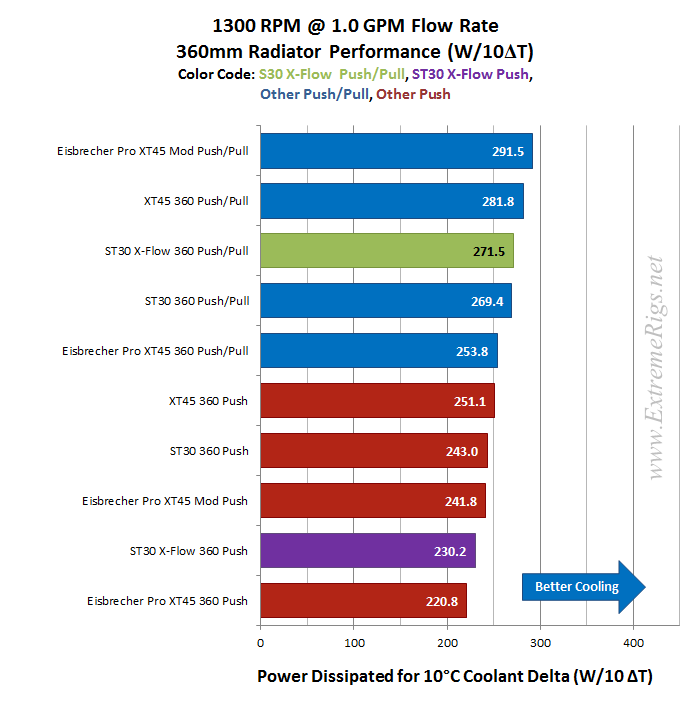
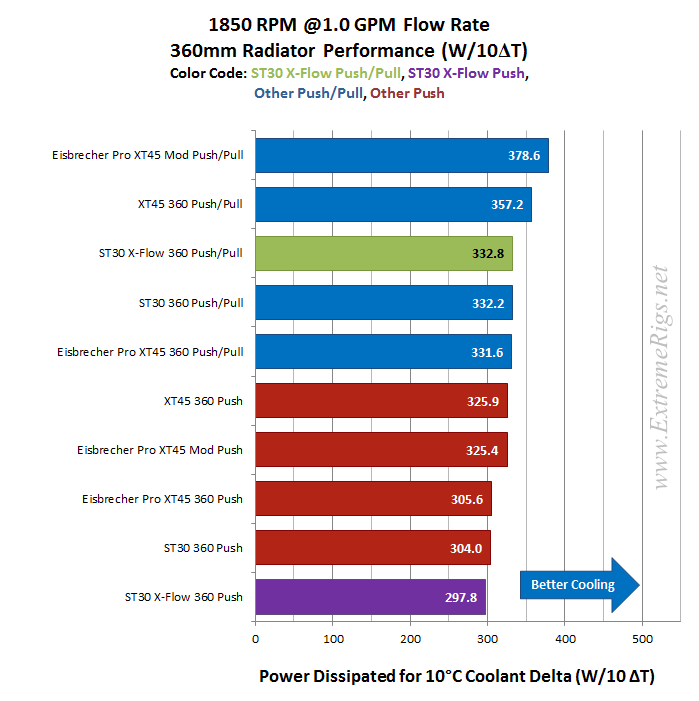 So, no real surprises there given it is a repeat of data, just bundled together.
So, no real surprises there given it is a repeat of data, just bundled together.
From all the 1.0 GPM test results we created “Average Performance Factor” charts for both Push and Push/Pull. We then made a combined plot of the average called the “Master Performance Factor”. The radiator with the best cooling ability (W/10ΔT) at each RPM was awarded a score of 100. Each other radiators W/10ΔT result was scored as percentage of the top performer.
This way of looking at the comparison takes away any advantages that a radiator may have at higher or lower fan speeds and looks at an overall average. While this appears fair it does tend to favor those radiators that are all-rounders and those radiators which do very well at high RPM. Most users should be more focused on their specific use case.
The following table shows the ST30 X-Flow’s percentage scores at each data point.
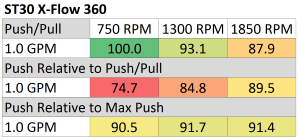
As the percentage scores in the table above are relative to the best performer at each data point, we again advise readers to cross reference specifications and results for each radiator and keep in mind your intended fan assembly and operating speed.
The percentage numbers above offer another way of comparing the ST30 X-Flow’s results. But for our scoring system we need a way to reduce the categories while retaining the data. To do this we average the results for each fan assembly type giving us Averaged Performance Factors. We calculate this for Push Only, Push/Pull and finally an average of everything. Again only the 1.0 GPM data has been used.
Firstly – the Push Only APF:
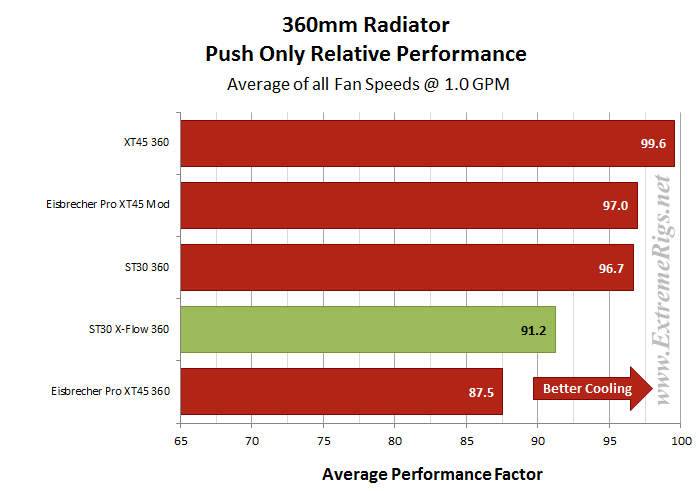 It really is only fair to compare the ST30 X-Flow against the regular ST30 because both the XT45 variants and our modified version have cores which are twice as thick. Having said that, keep an eye on the Eisbrecher Pro placings in comparison to the ST30 X-Flow in these plots. The weaker Push Only performance of the X-Flow meant that it finished 5.5% behind the regular ST30.
It really is only fair to compare the ST30 X-Flow against the regular ST30 because both the XT45 variants and our modified version have cores which are twice as thick. Having said that, keep an eye on the Eisbrecher Pro placings in comparison to the ST30 X-Flow in these plots. The weaker Push Only performance of the X-Flow meant that it finished 5.5% behind the regular ST30.
Now the Push/Pull APF:
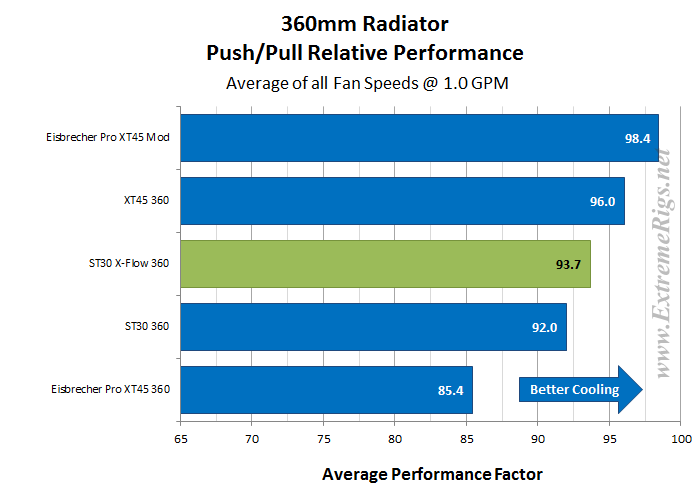 In the Push/Pull APF the ST30 X-Flow turned the tables and finished with a slightly higher Push/Pull result than the standard ST30 thanks to it’s stronger performance with low speed fans.
In the Push/Pull APF the ST30 X-Flow turned the tables and finished with a slightly higher Push/Pull result than the standard ST30 thanks to it’s stronger performance with low speed fans.
Finally for thermal performance we created the Master Performance Factor which is calculated from the averaged results of all the Push Only and Push/Pull thermal tests at all fan speeds with a 1.0 GPM flow rate.
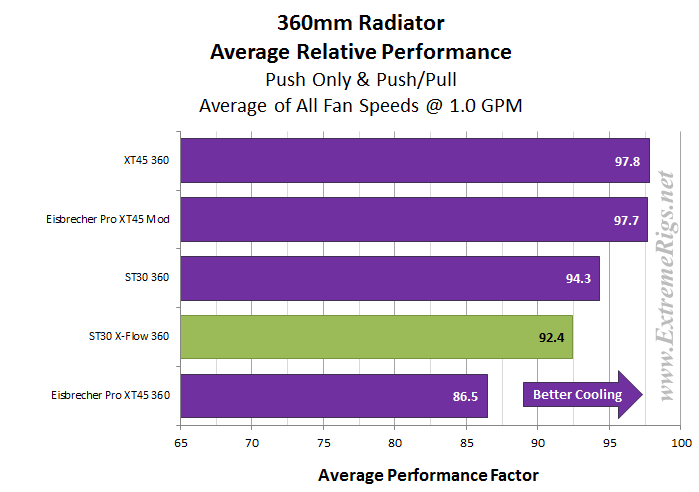 The MPF result of 92.4 places the ST30 X-Flow just behind the regular ST30 and just over 5% behind the leading rads with a 33mm thick core. We reckon this is a pretty darned good result for both of the ST30 variants considering they have half the core thickness (16mm) of their bigger XT45 siblings.
The MPF result of 92.4 places the ST30 X-Flow just behind the regular ST30 and just over 5% behind the leading rads with a 33mm thick core. We reckon this is a pretty darned good result for both of the ST30 variants considering they have half the core thickness (16mm) of their bigger XT45 siblings.
Space Efficiency
The ST30 X-Flow’s space efficiency vs. performance should result in a high score because it is the equal thinnest of the group. We have used the Average Performance Factor results from the charts above to compile two plots which shows us how it compares to the other radiators in terms of performance Vs. space taken.
Firstly is radiator thickness Vs. APF
Here the combined APF scores were divided by the only radiator thickness, with the highest (most space efficient) issued a score of 100. Each of the other radiators results was converted to a percentage of the most space efficient radiator’s score.
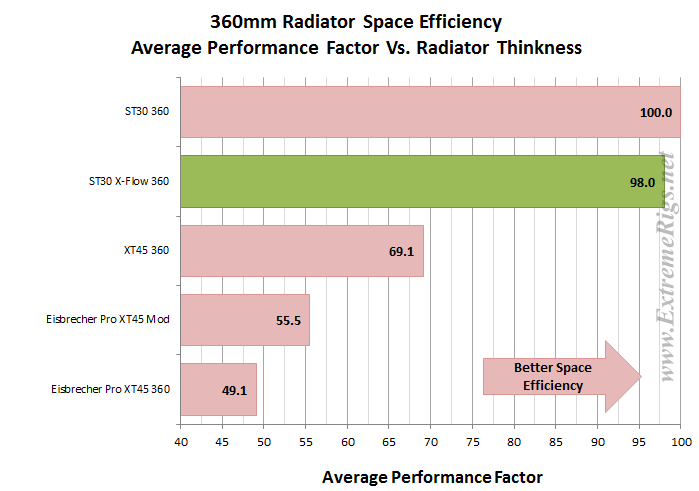
The results certainly favor the two slim radiators with the X-Flow just being beaten by the regular ST30.
Next we took the APF results for Push/Pull and divided it by the total thickness including the fans and applied the same scoring system. For the Push Only we used the Push Only Vs Push/Pull comparative results and applied the same scoring system when compared against the Push/Pull.
The rankings are ordered for Push Only as that is the most efficient fan assembly and each radiator’s Push/Pull result are placed un-ordered, just below it’s ranked Push Only score.
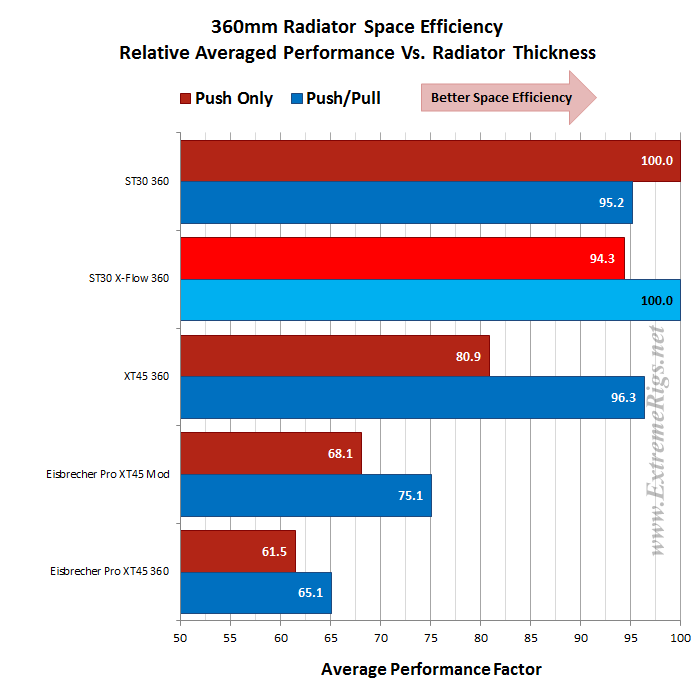 This plot is likely the most useful for readers of the 2 plots for space efficiency even though it is harder to decipher, especially the Push/Pull rankings. With fan thickness factored in the ST30 X-Flow finishes 2nd for Push Only and 1st for Push/Pull.
This plot is likely the most useful for readers of the 2 plots for space efficiency even though it is harder to decipher, especially the Push/Pull rankings. With fan thickness factored in the ST30 X-Flow finishes 2nd for Push Only and 1st for Push/Pull.
Value Factor
While our APF’s are still fresh in mind, let’s now look at some performance results vs radiator price to show which of the 360mm radiators might offer the best bang for your buck. Each radiator’s combined APF scores were divided by the radiator cost and again we applied our scoring system of percentage Vs. the best performer of the category.
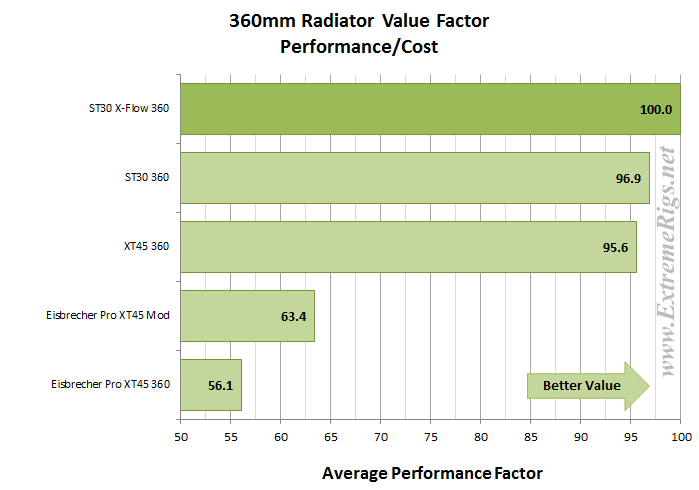 The ST30 X-Flow’s Value Factor turns out very good indeed. Whatever the reason Alphacool have for pricing the X-Flow lower than the regular ST30, it helped it into 1st place for this metric.
The ST30 X-Flow’s Value Factor turns out very good indeed. Whatever the reason Alphacool have for pricing the X-Flow lower than the regular ST30, it helped it into 1st place for this metric.
Next Up – Summary!
Summary
Thermal Performance
Thermal Performance scores are derived from the relevant Performance Factor scores. We set this scale with 75% and below as the 0 mark, with each 2.5% increase from 75% in relative performance adding 0.5 to the awarded performance score.
Note On Thermal Performance Scores Below: The XT30 X-Flow is being scored comparatively against results from a very small test group of only 3 other radiators (plus one modified version). Of those 4 other scores being compared against, there is only one other slim radiator. That being the case we are putting very little emphasis on the summary scores that follow and we urge readers to do the same. Instead we advise to go back through the review and use the comparative performance scores that relate to your intended fan set-up and speed.
Push Only Thermal Performance
- 3.5/5
The ST30 X-Flow’s Push Only APF result of 91.2% translated into a performance score of 3.5/5. Compared to the other slim radiator in the group it had weaker performance at low fans speeds but improved as the fan speeds got higher.
Push/Pull Thermal Performance
- 4/5
The Push/Pull APF result of 93.7 translated into a thermal performance score of 4 out of 5. The ST30 X-Flow proved to be a good all-round performer with a Push/Pull fan assembly. It even topped the chart at 750 RPM where the single pass seemed to have the advantage over the other radiators in the group.
Overall Thermal Performance
- 4/5
The Master Performance score of 92.4 generated an above average score of 3.5 and was painfully close to being a 4/5. Performance was never expected to be amazing, being a slim radiator, but I think it’s fair to say that we were pleasantly surprised that the ST30 X-Flow did as well in the comparisons as it did.
Performance is not the be all and end all factor in making a purchase decision, though for many it is high on the selection criteria.
Features & Quality – 4.5/5
Many of the radiators on the market are lacking the features we like to see, particularly the slim radiators. The ST30 X-Flow bucks the trend as it sports just about everything we want on a PC radiator.
Well designed end tanks with multiple port options are great. The tube protection plates are a great design and the ST30 X-Flow appears puncture proof when fans are installed using the provided custom length screws. The slim design means it can fit in spaces many others can’t and the X-Flow design means less tubing is required to plumb up the system which results in a cleaner overall look.
The build quality and finish was almost perfect and the unit feels very solid without any twist or flex. The satin black paint finish is excellent but we do wish that the port threads were not painted in the process. The single louvered fins were very evenly spaced between the tubes, but our sample had a slightly lower FPI count than the specifications indicate.
The core seems biased towards medium and high speed fans, and being X-Flow it will perform better with higher coolant flow rates. We can’t say with any certainty what the low flow cut off point would be before a laminar flow prevails, but we would not advise a system flow rate much lower than the 1.0 GPM. No matter what flow rate you settle on restriction levels on the ST30 X-Flow will never be a problem and therefore not pose any issues for pump power requirements.
Summary – 4/5
The ST30 X-Flow proved to be a solid all round performer which has a slight bias towards higher air flow through the slim, medium dense core. Design and quality control is excellent and with it now available for under $70 we think it’s reasonably priced. Please keep in mind that we advise a system flow rate of at least 1.0 GPM for the ST30 X-Flow.
For many years X-Flow radiators were the ugly duckling of the radiator market. We’ve always had a bit of a soft spot for them purely for the less complicated tube routing with either soft tubing or hard tube. As more emphasis than ever is placed on the aesthetics of custom water cooled PC’s (cooling potential has pretty much peaked) we believe that X-Flow radiators will becoming more commonplace in the builds you drool over in the forums.
The ST30 X-Flow is a great 360mm option because it’s slim, is X-Flow, has a very low restriction level, has extra port options and it’s a decent performer. We can’t ask for much more.
Extreme Rigs Silver Award.
Where to buy:
 Aqua Tuning: Alphacool ST30 X-Flow 360mm $74.58 + shipping
Aqua Tuning: Alphacool ST30 X-Flow 360mm $74.58 + shipping
 Alphacool Store: Alphacool ST30 X-Flow 360mm €71.95 + shipping from Europe
Alphacool Store: Alphacool ST30 X-Flow 360mm €71.95 + shipping from Europe
 Performance PCs: Alphacool ST30 X-Flow 360mm $74.95 + shipping from USA
Performance PCs: Alphacool ST30 X-Flow 360mm $74.95 + shipping from USA
 ModMyMods: Alphacool ST30 X-Flow 360mm $67.45 + shipping from USA
ModMyMods: Alphacool ST30 X-Flow 360mm $67.45 + shipping from USA




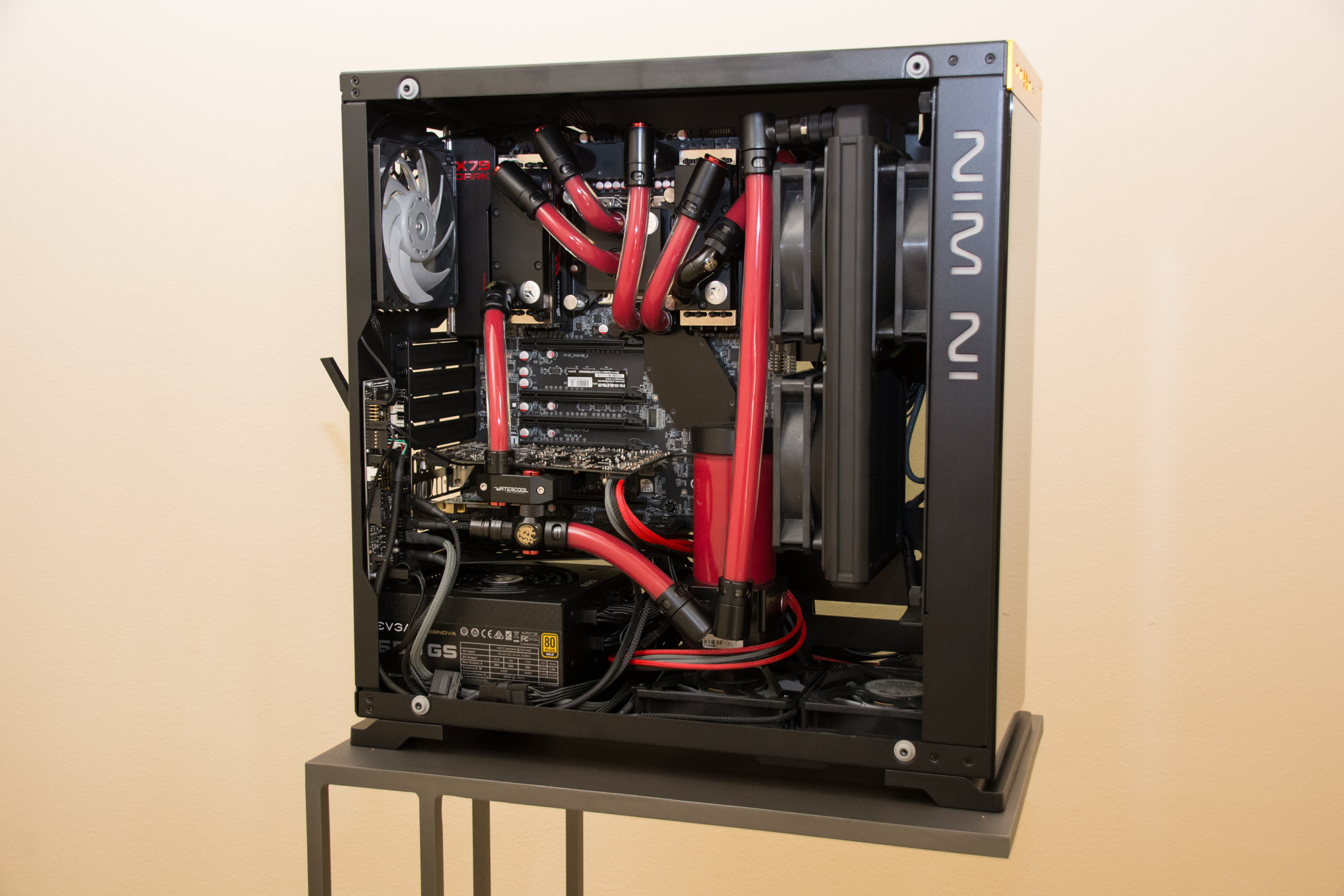
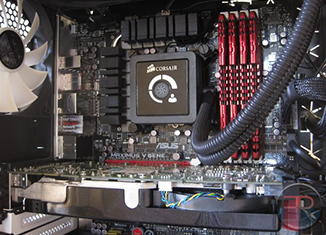

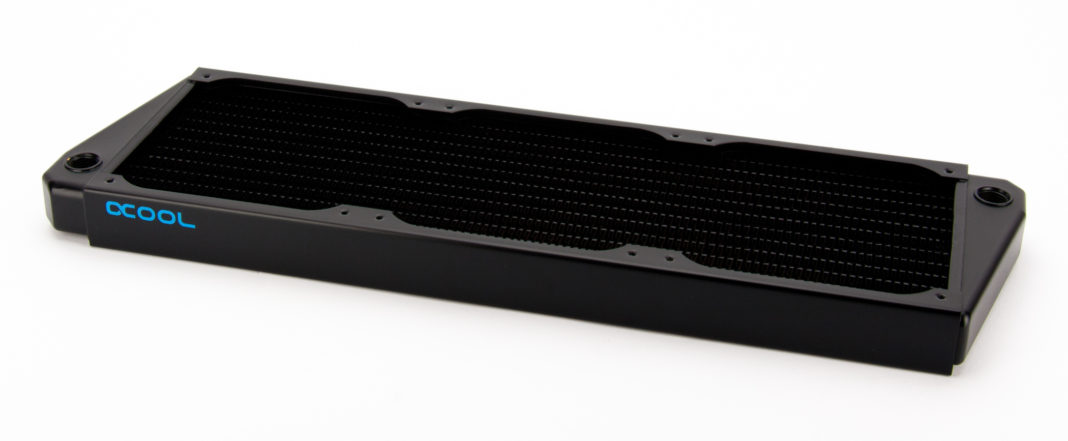
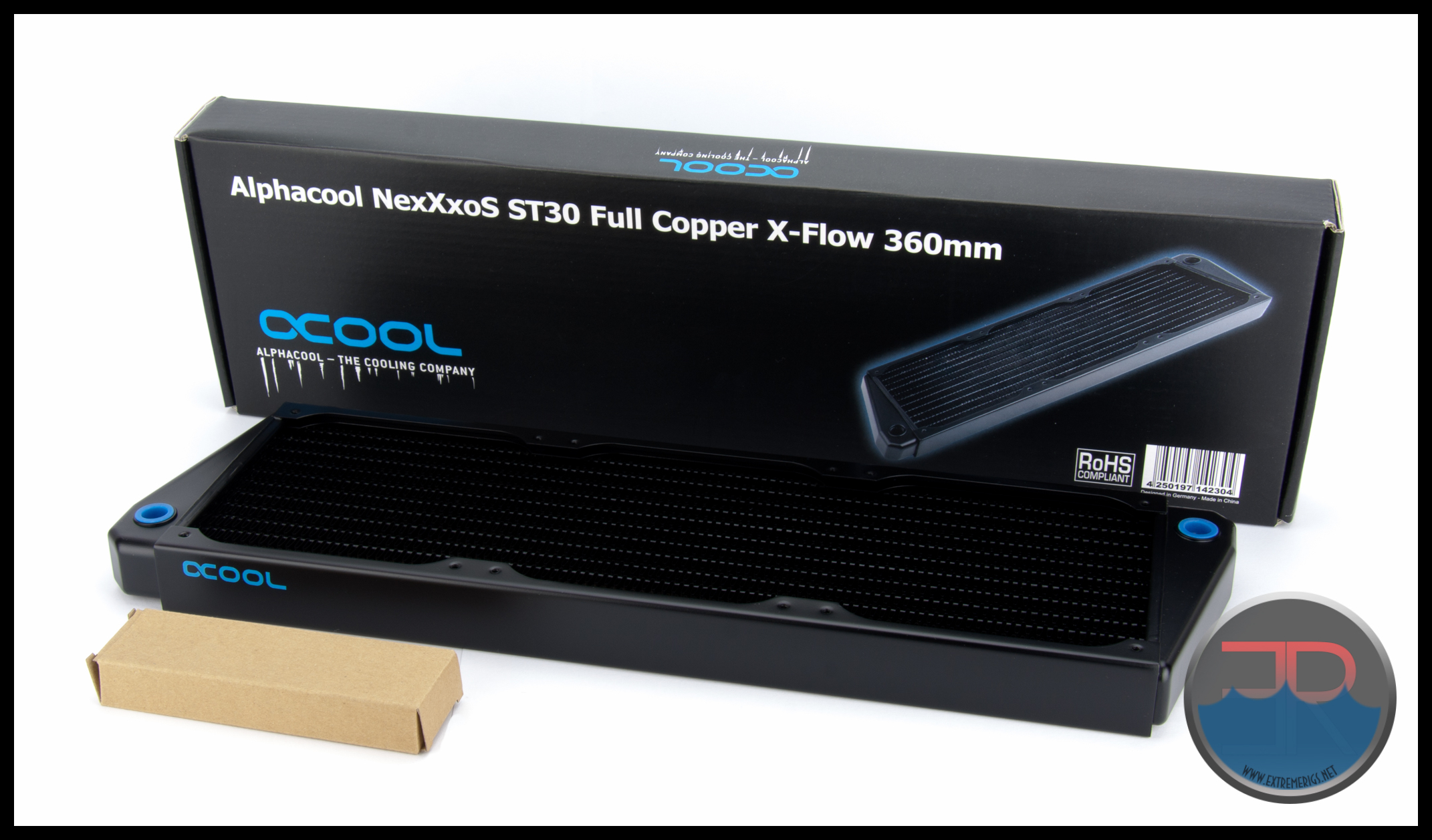
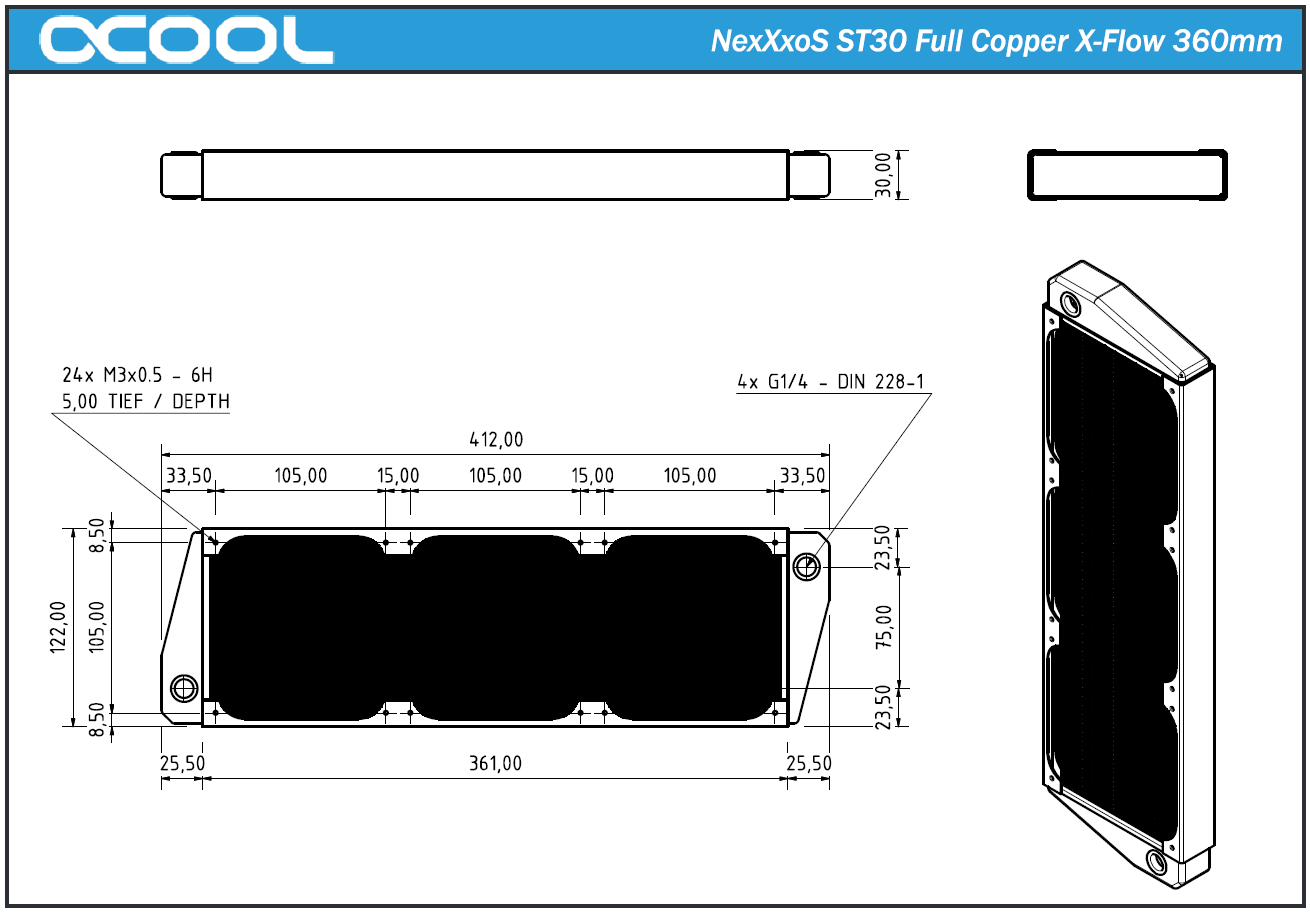

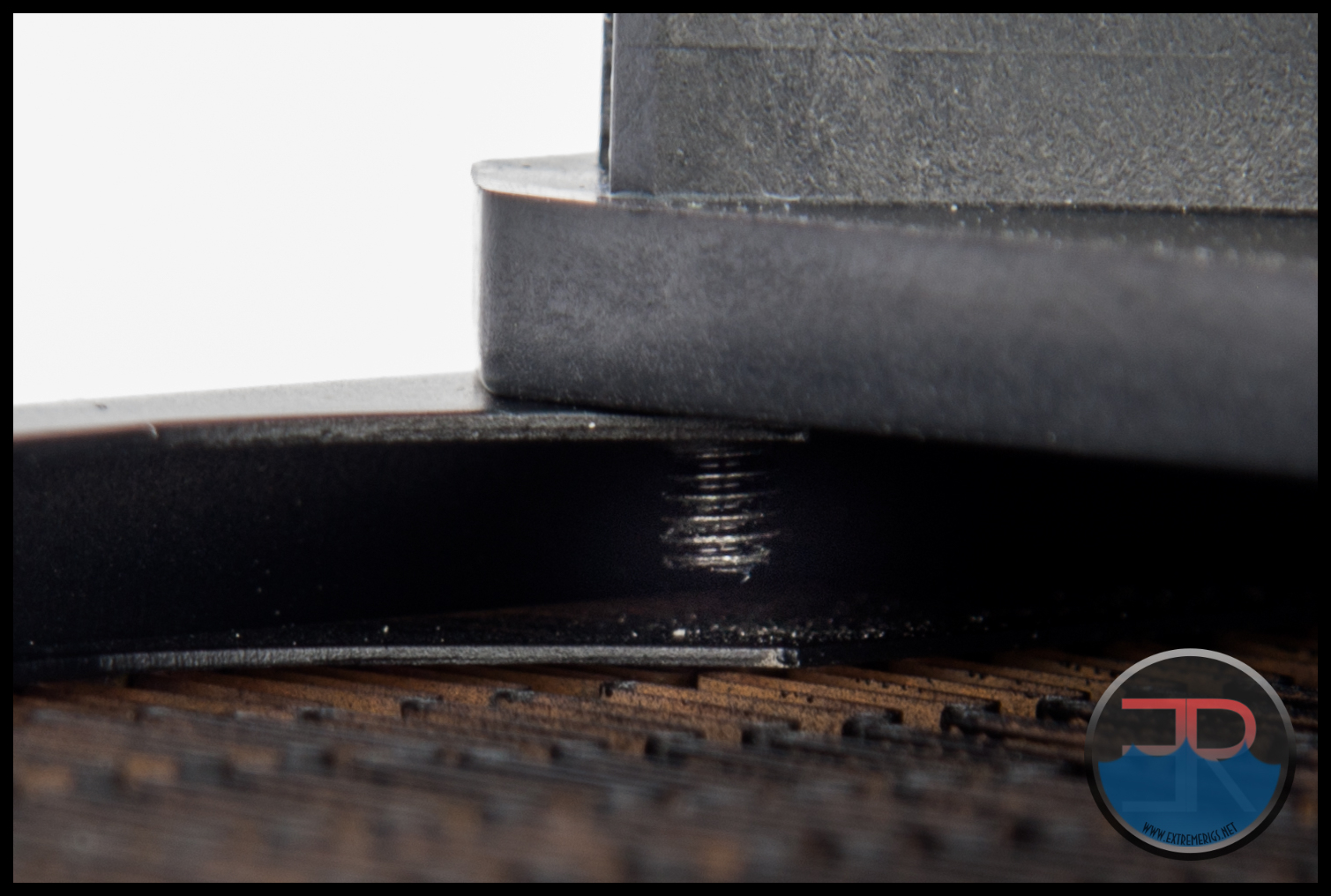
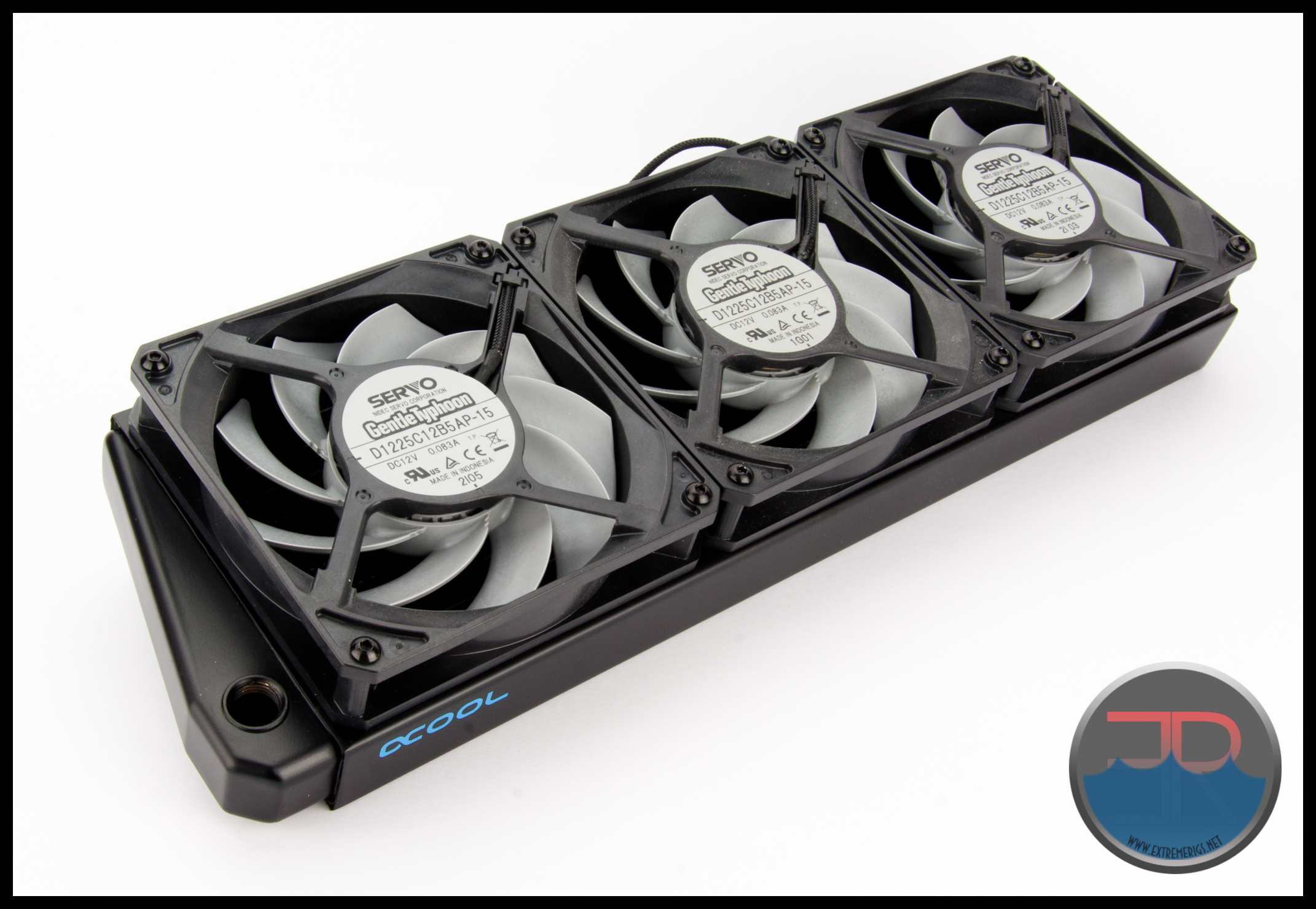
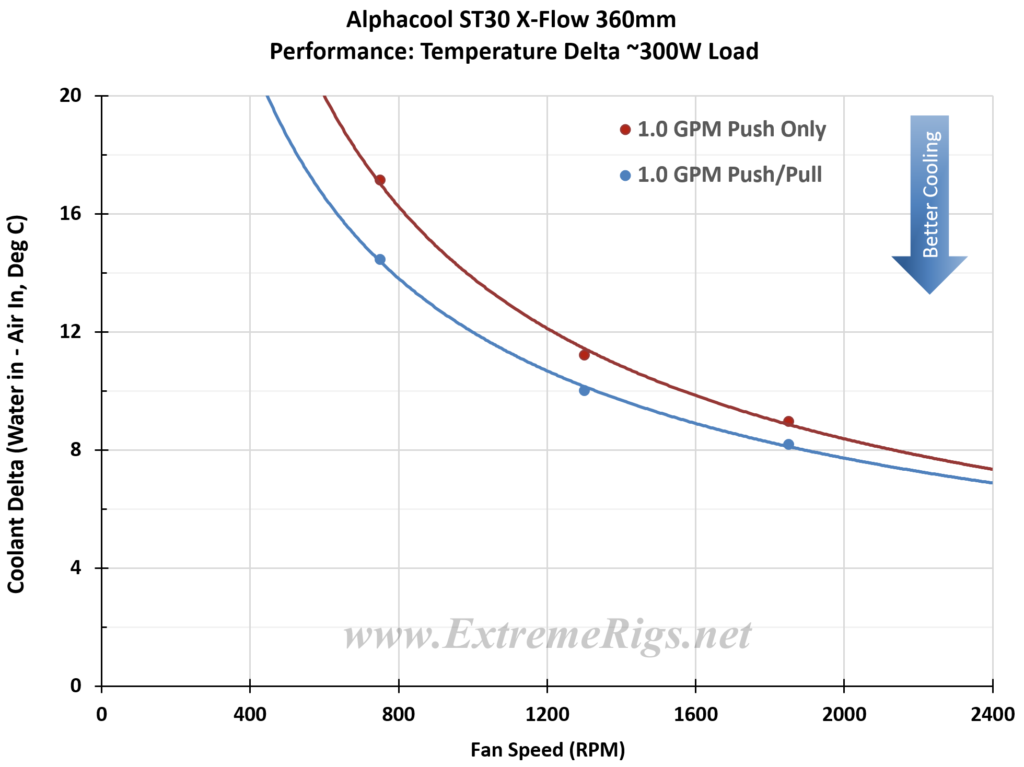
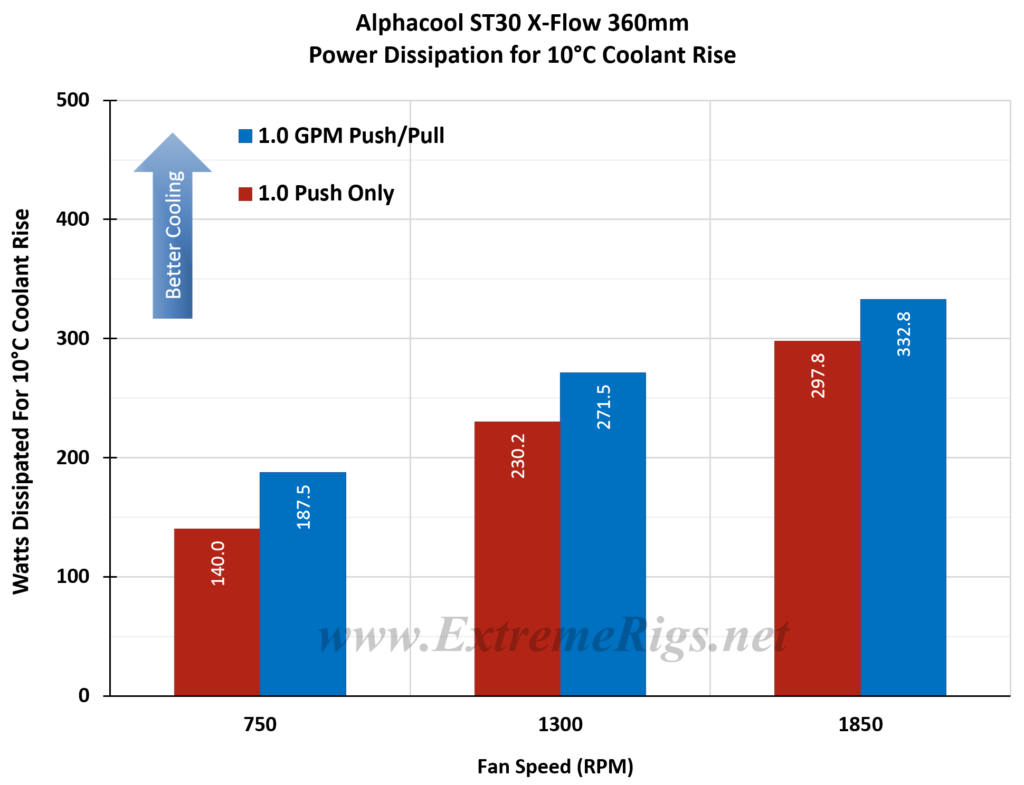
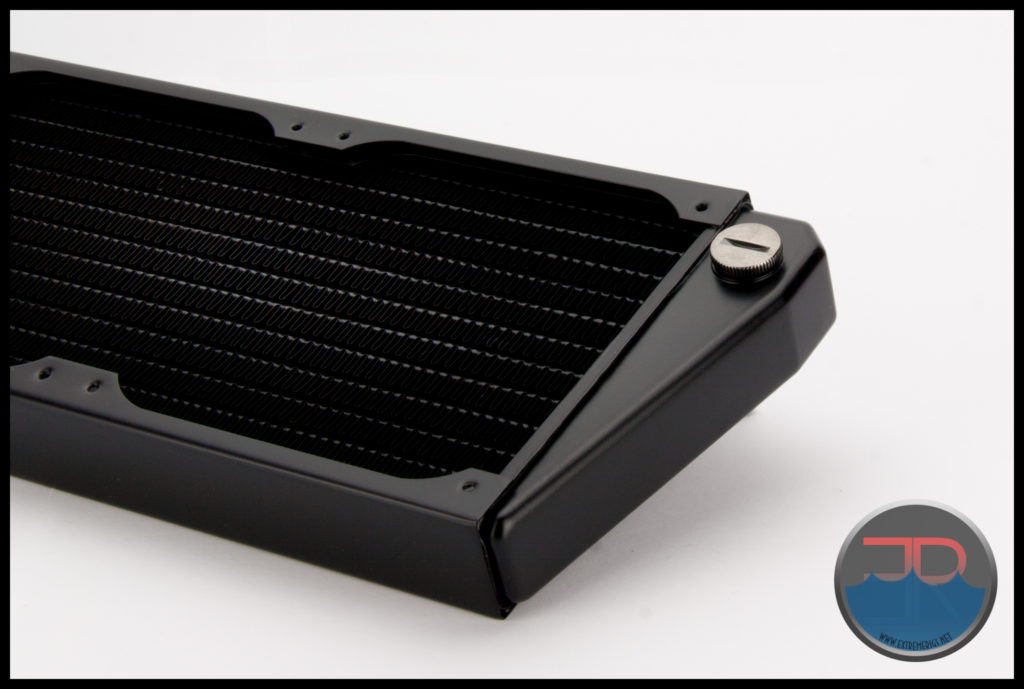

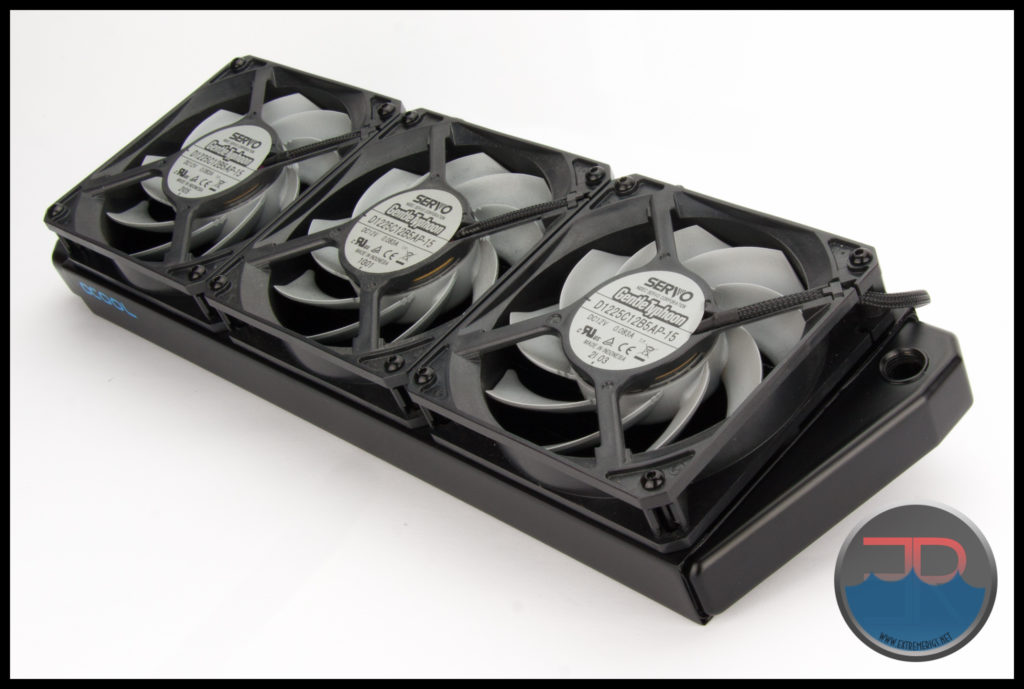
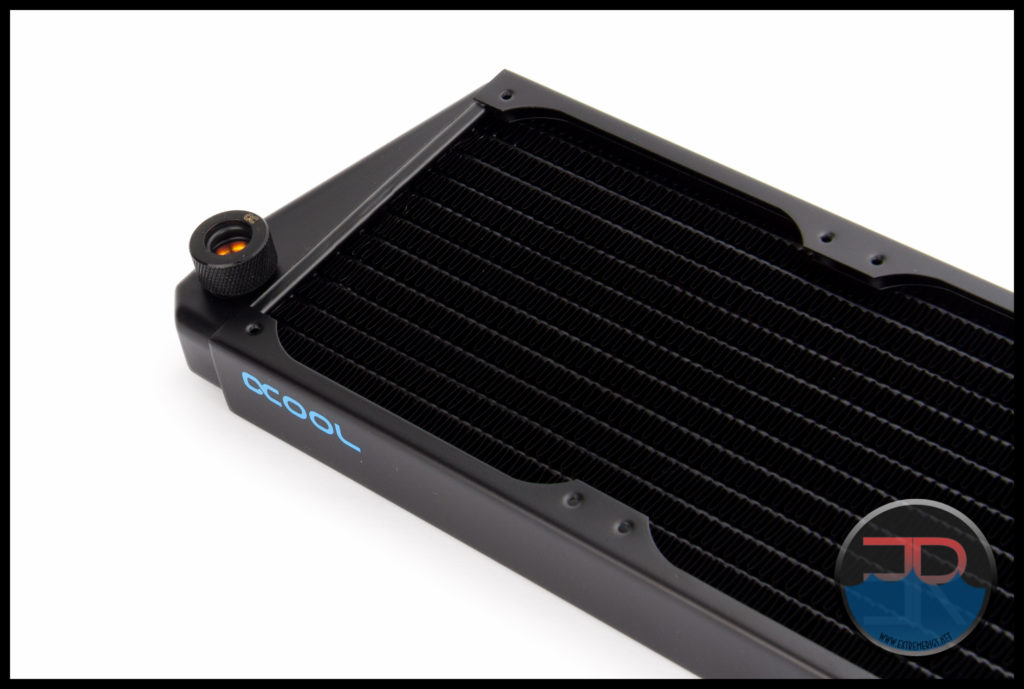
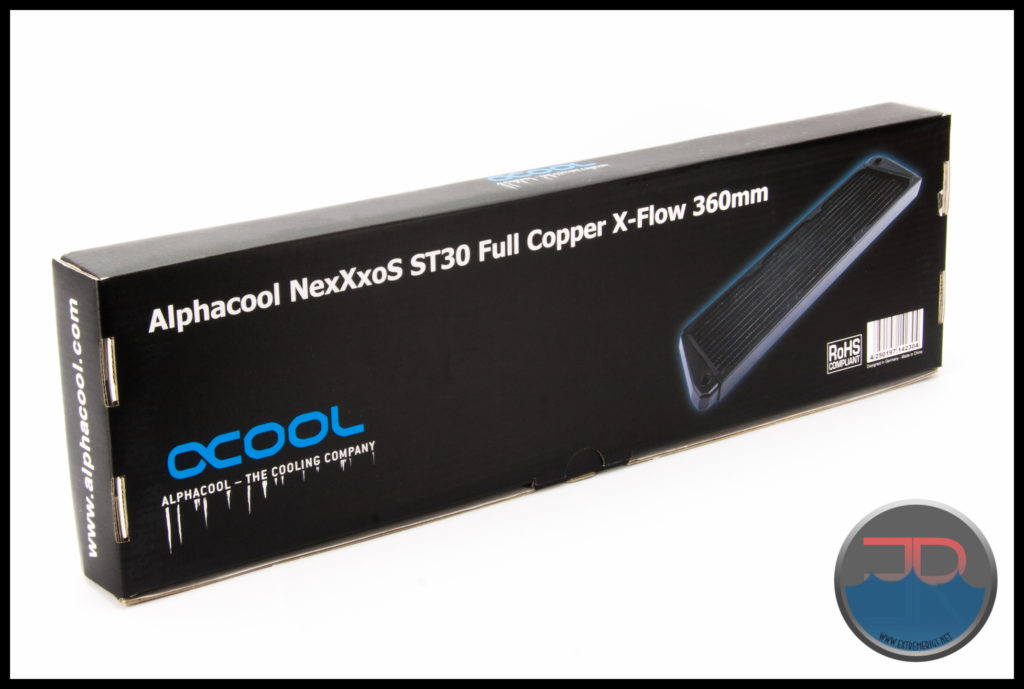

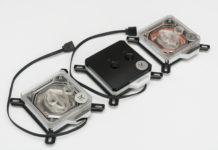

Are there some thicker cross flow radiator on the market?
Alphacool also have x-flow versions of their other radiators such as the XT45 and UT60. If you want thickest I think the UT60 is the only choice out there 🙂
Is this the best cooling 30mm rad on the market? Thanks!
In general the Black Ice Nemesis GTS generally seems to perform the best out of any slim radiators though the tradeoff is that it’s very high restriction.
Does that cancel out their overall performance though (which seems excellent)? I would have thought for the vast majority loops the Nemesis GTS would still be the best choice when seeking a low RPM rad solution?
Not usually in my opinion, but if you are going to run a bunch in series with a weak pump, then yes it may.
In the 360mm size?
Comments are closed.